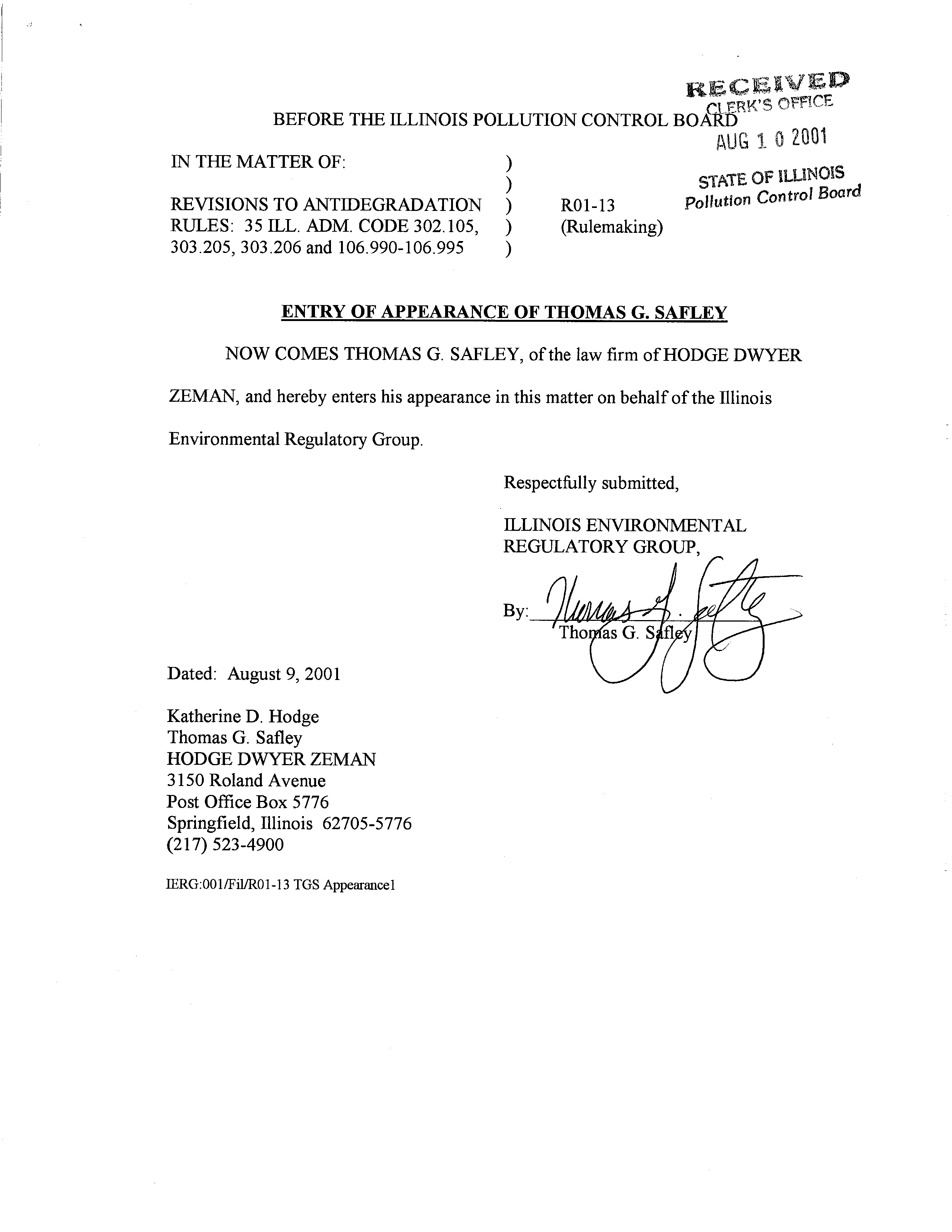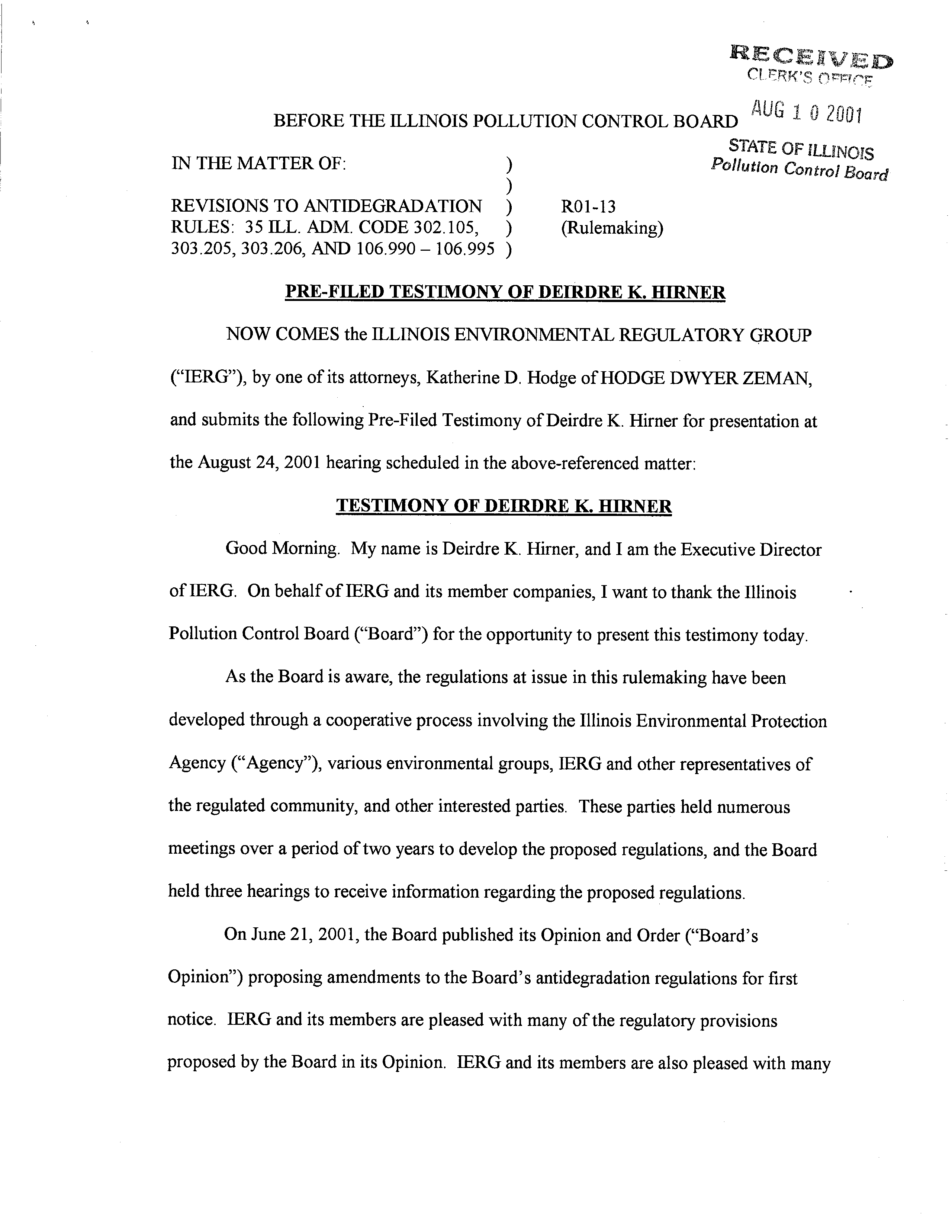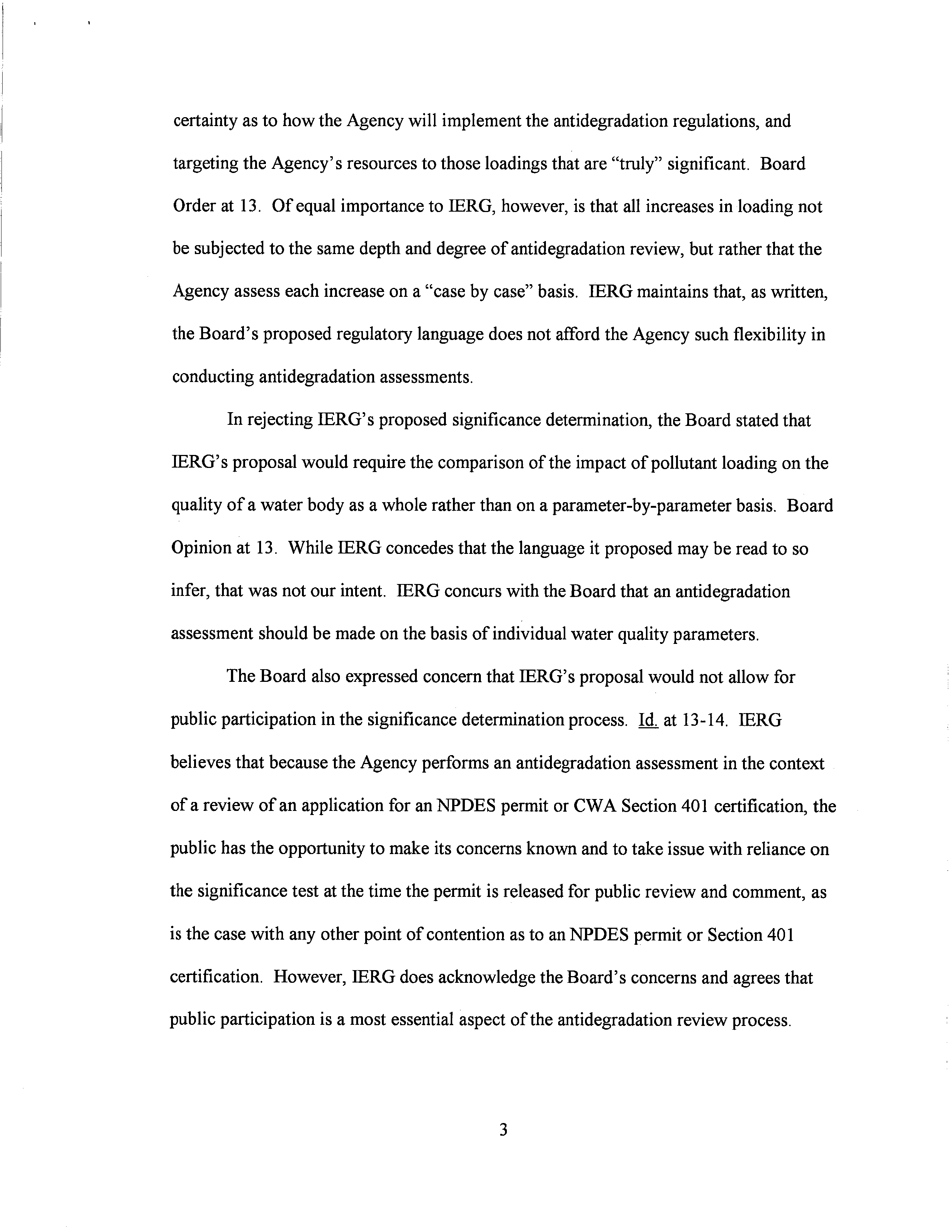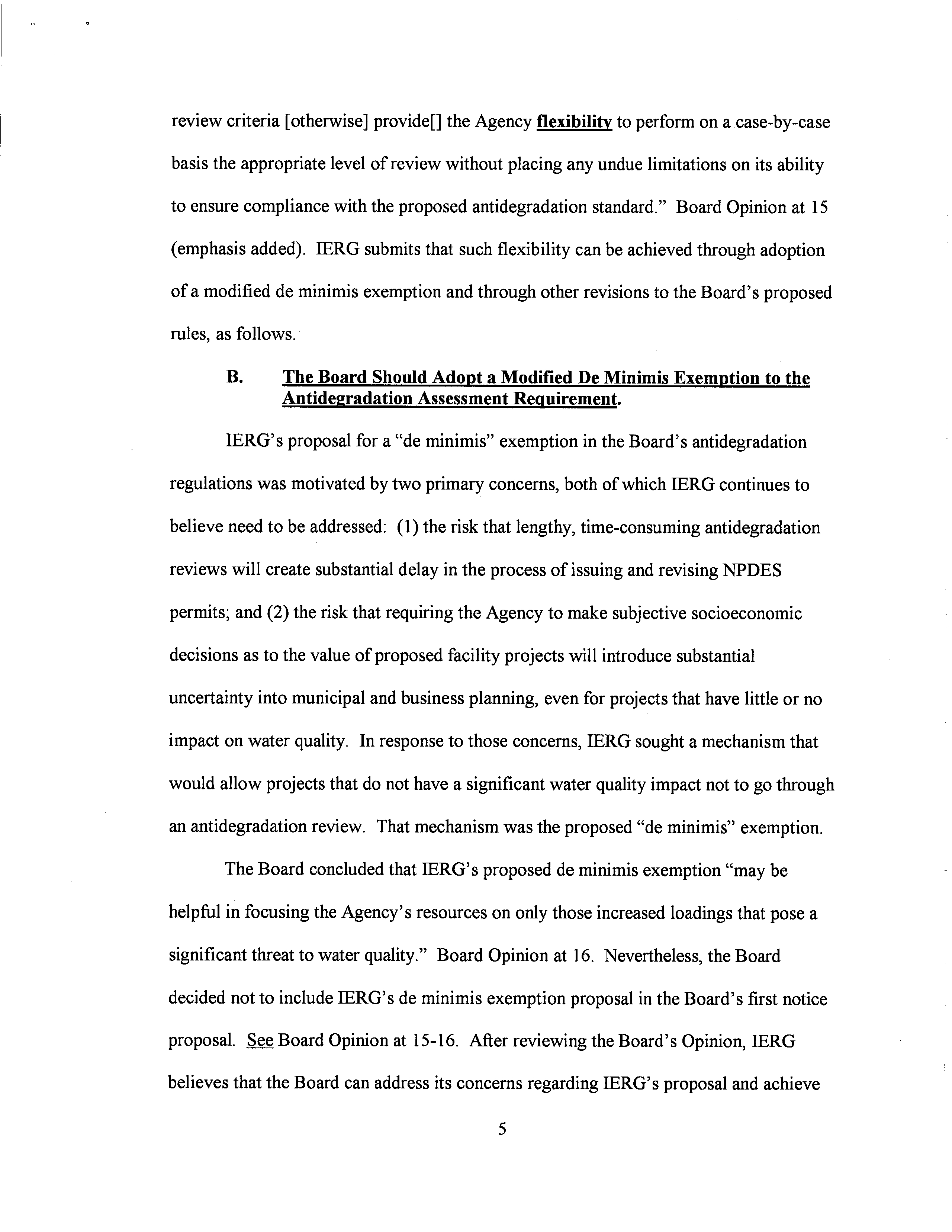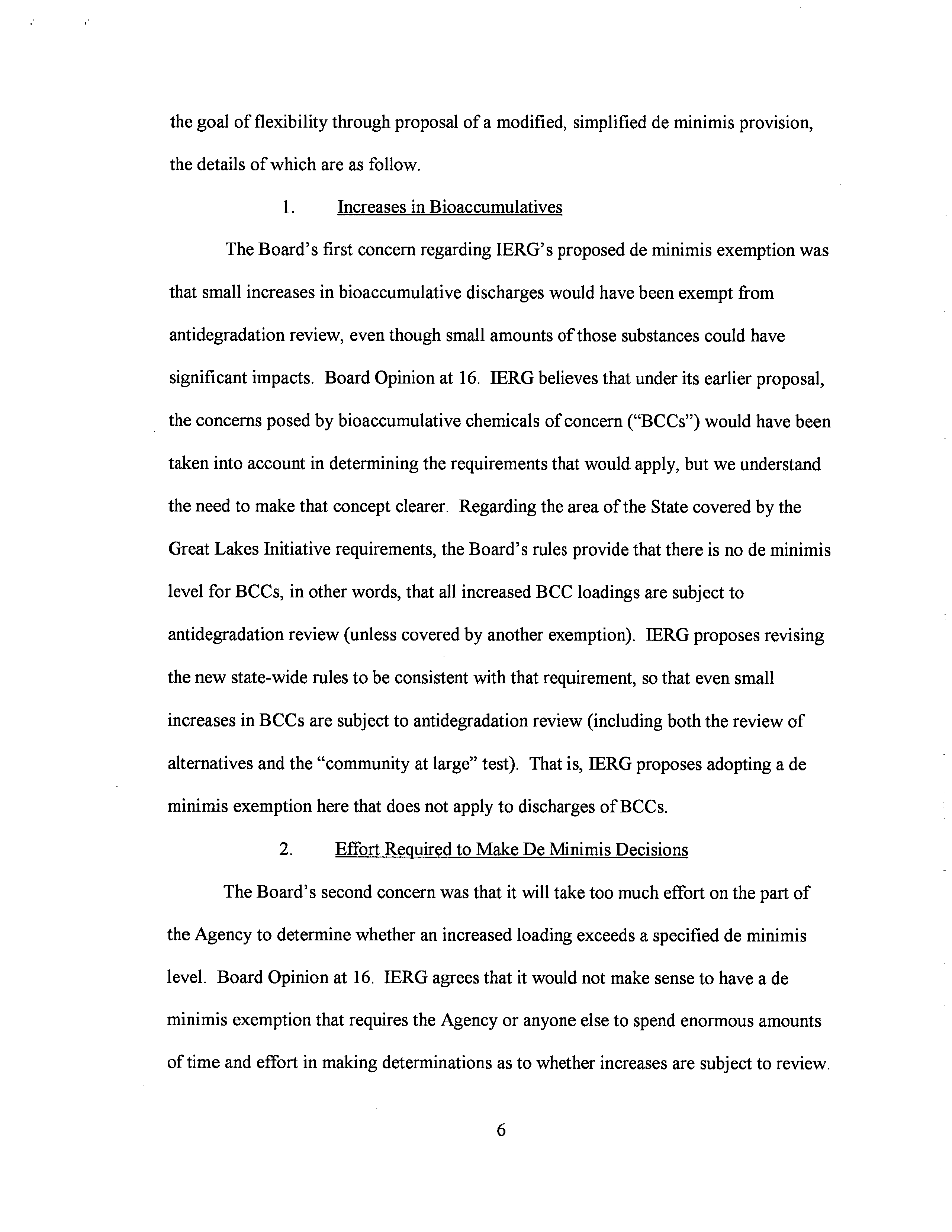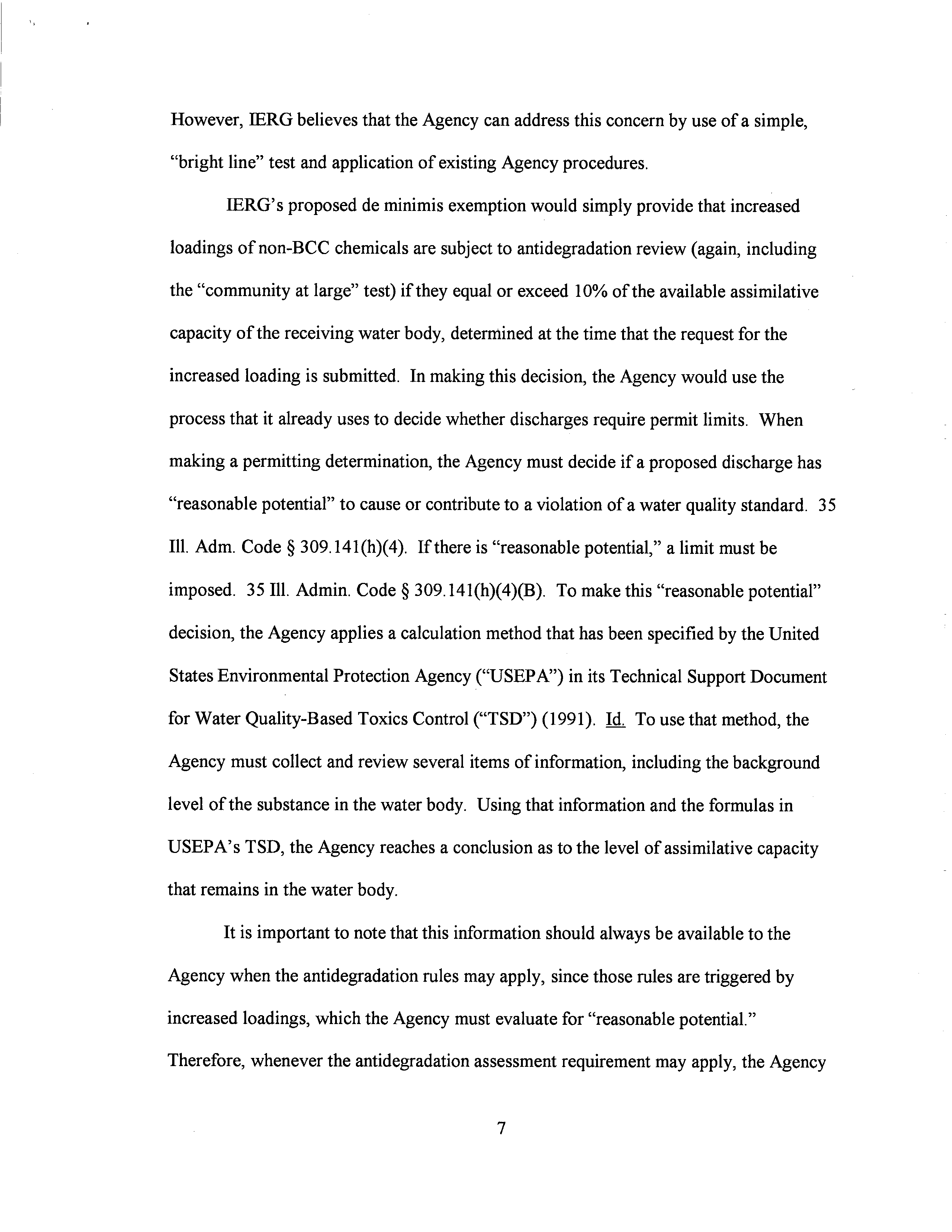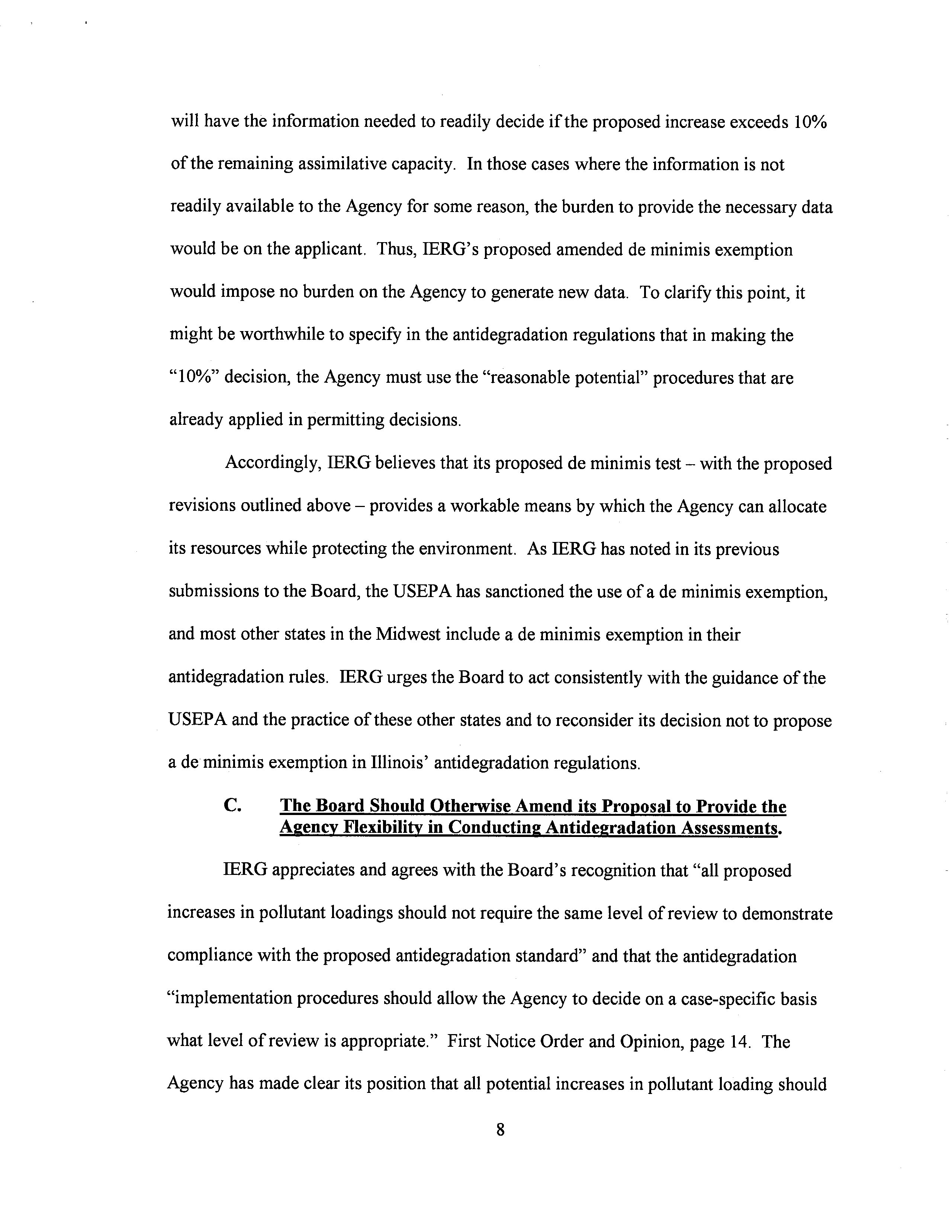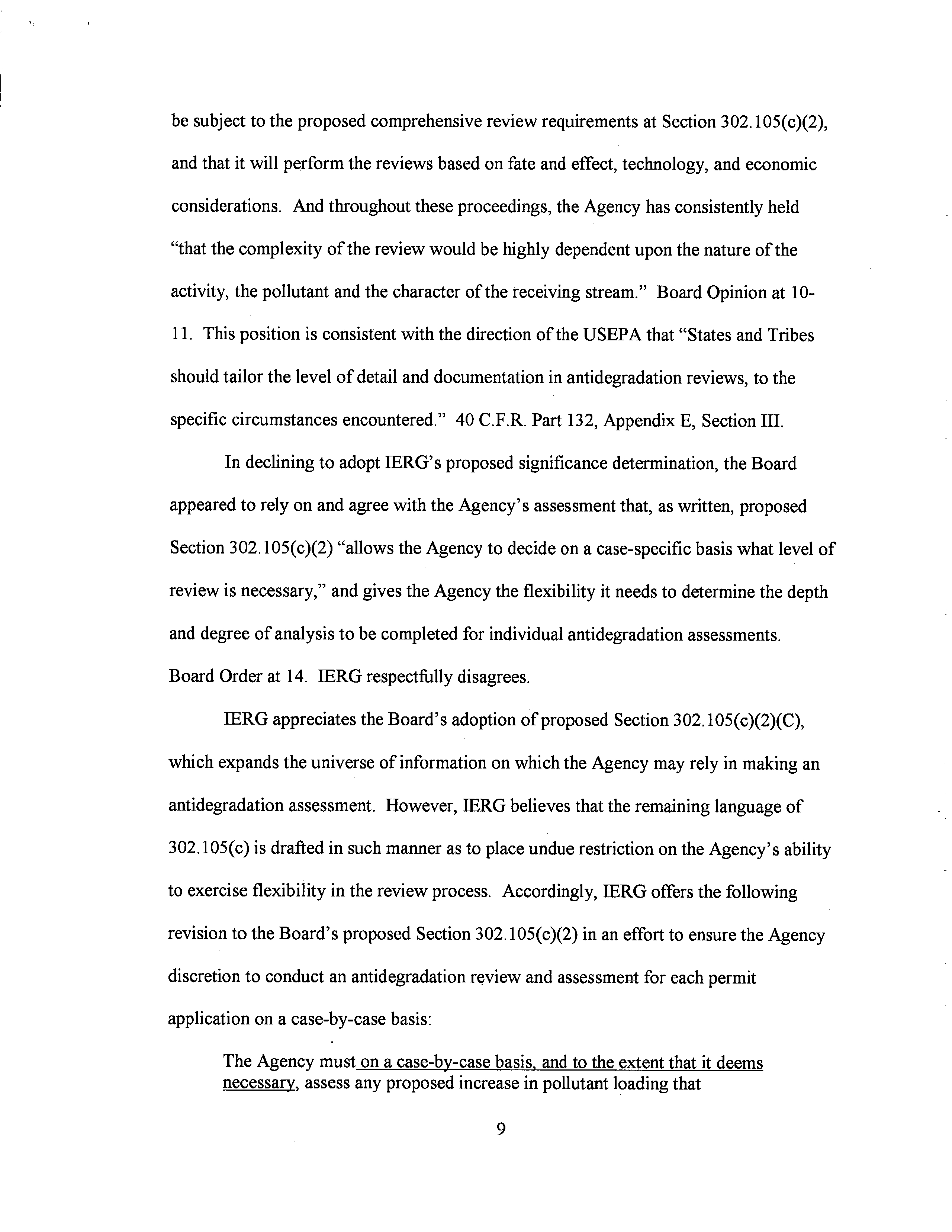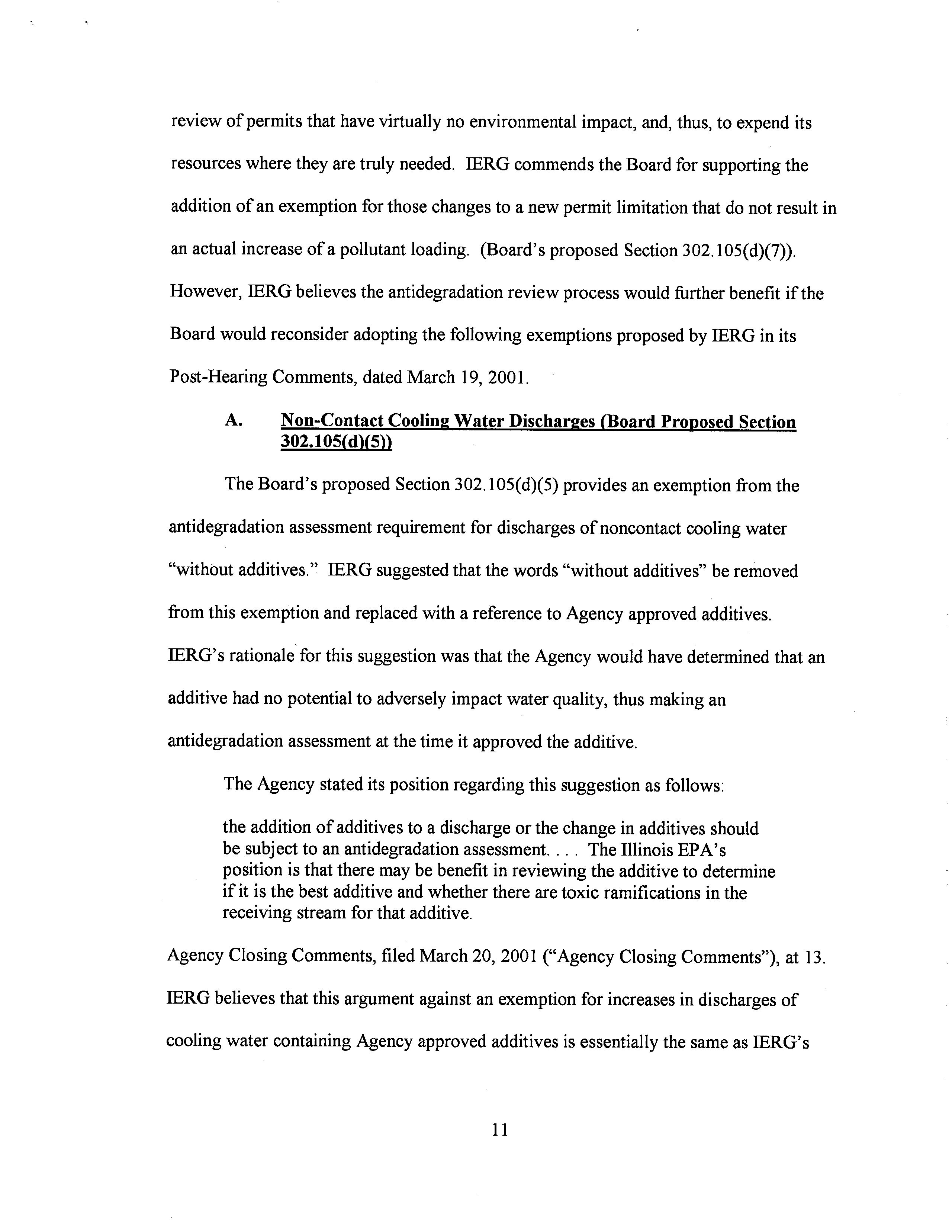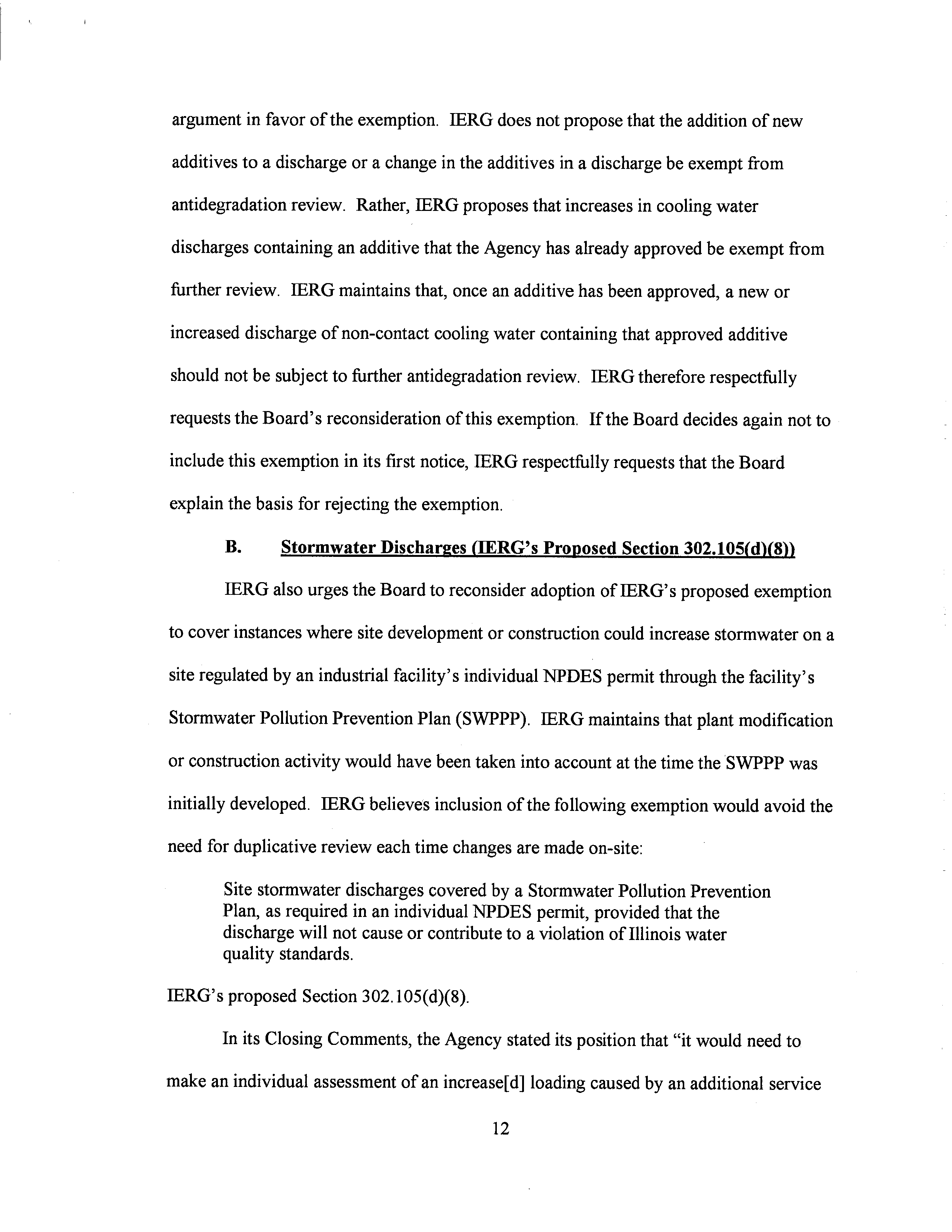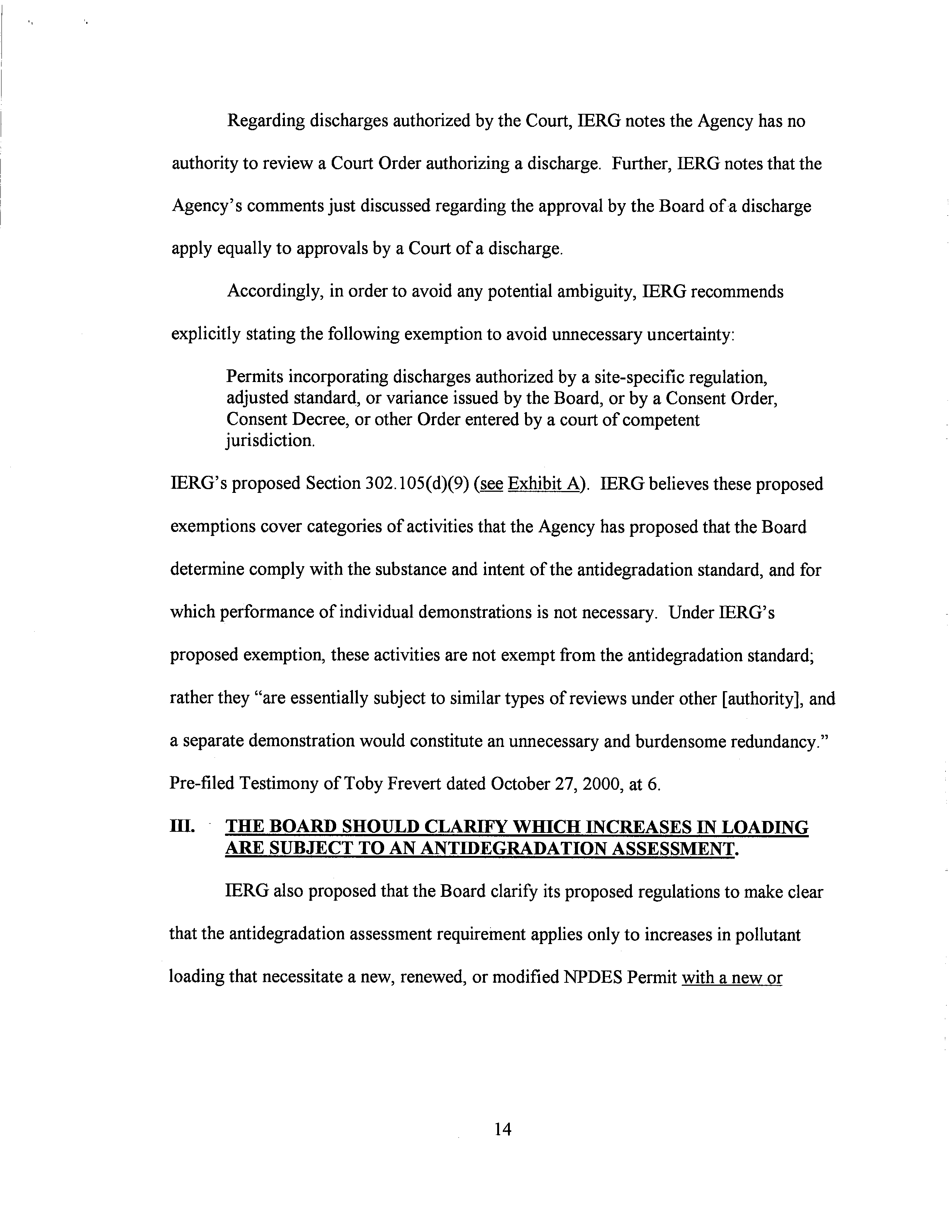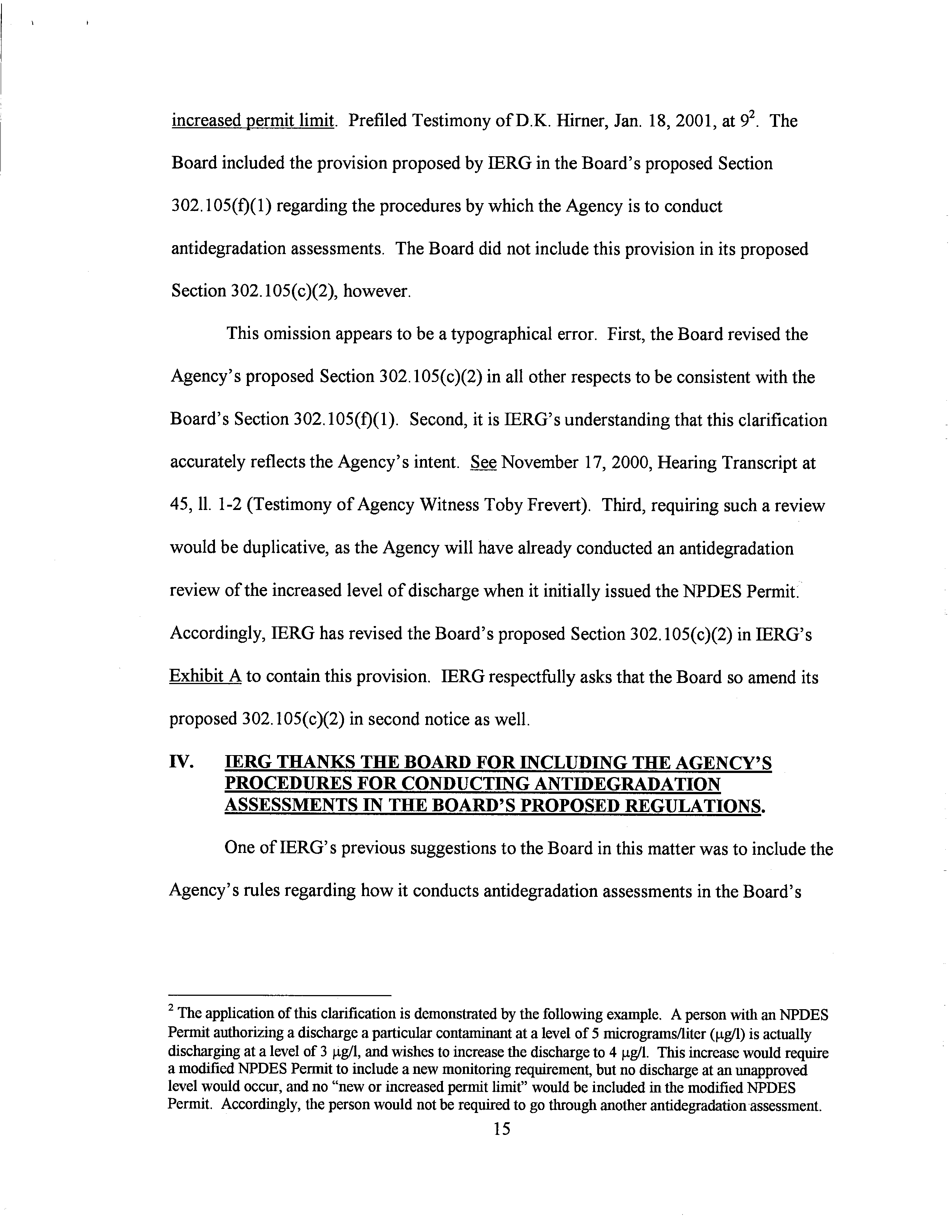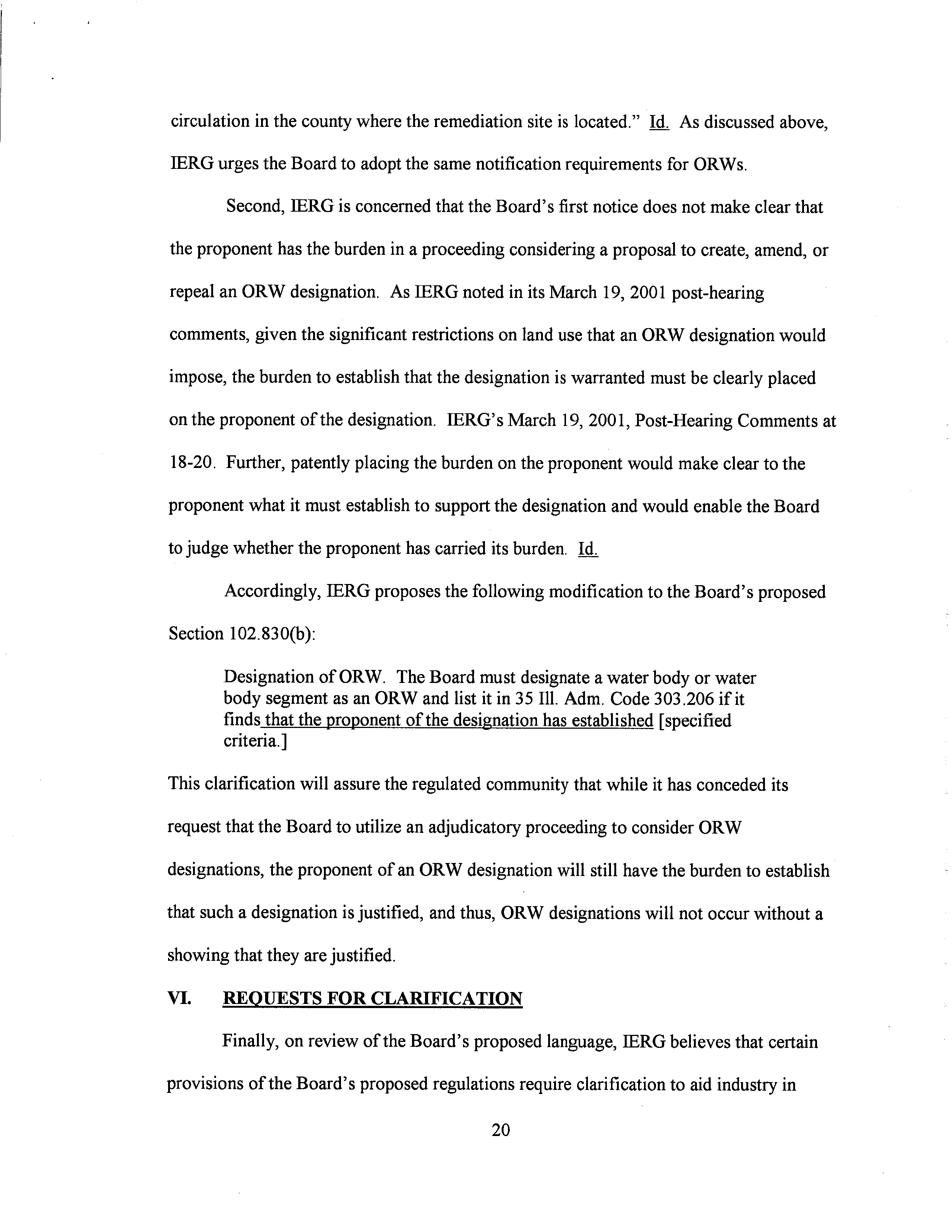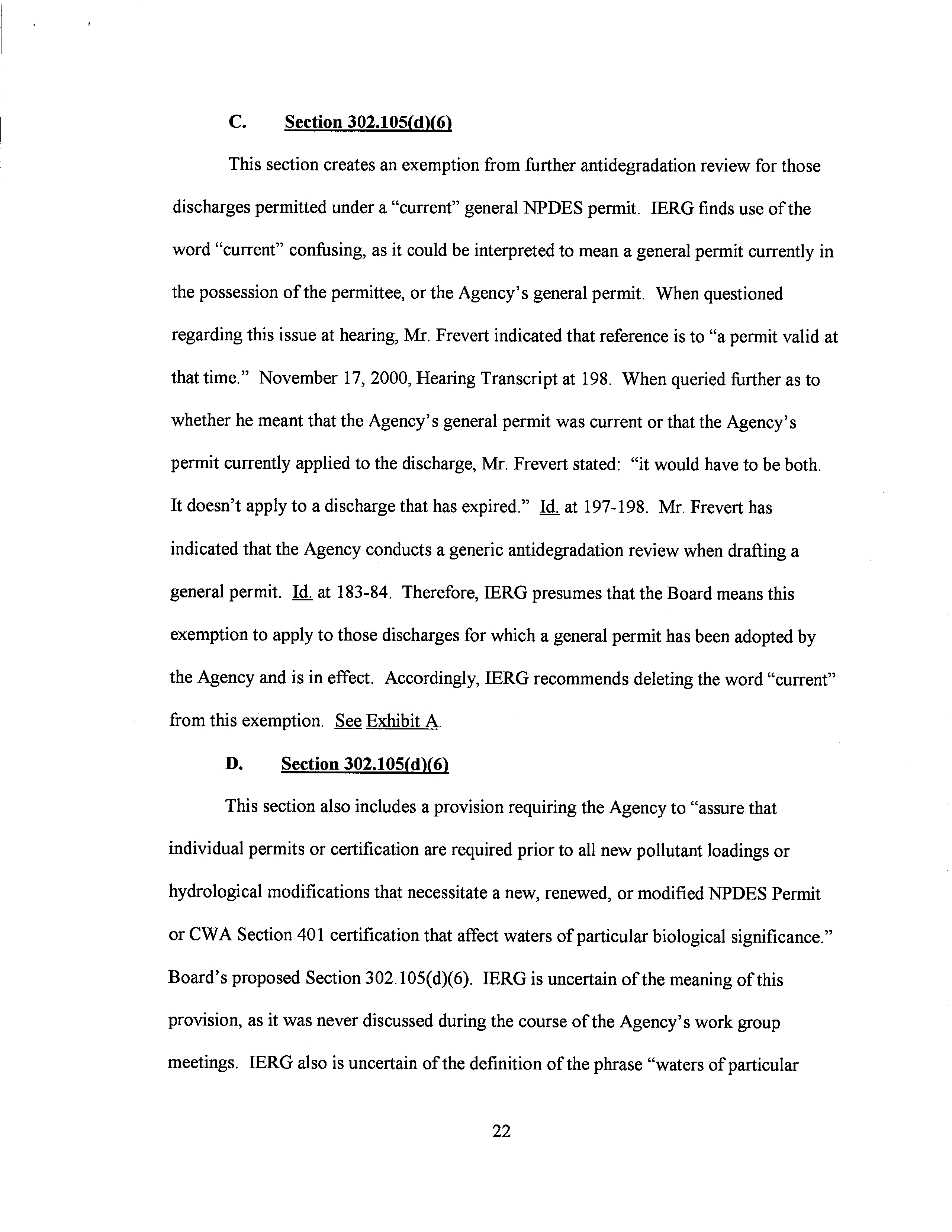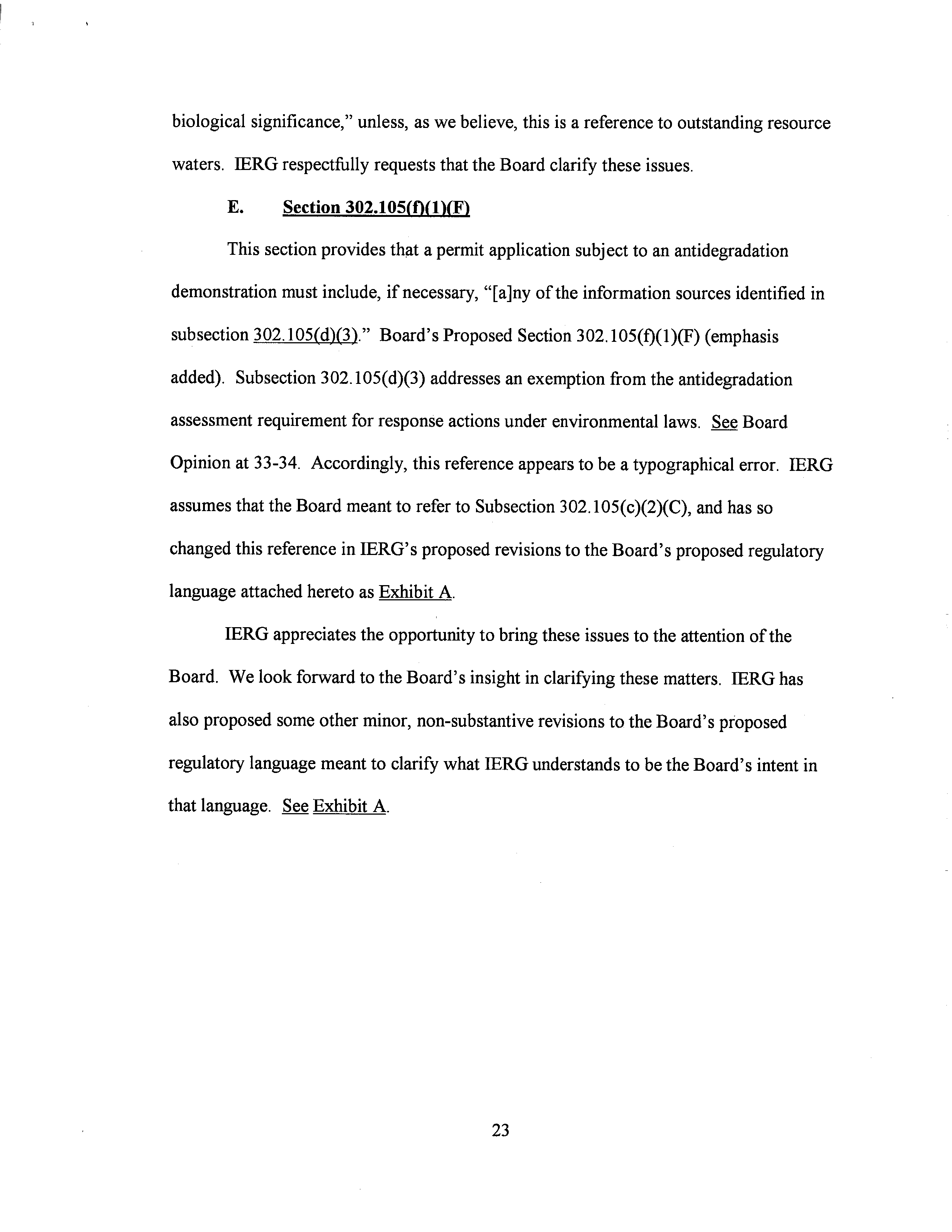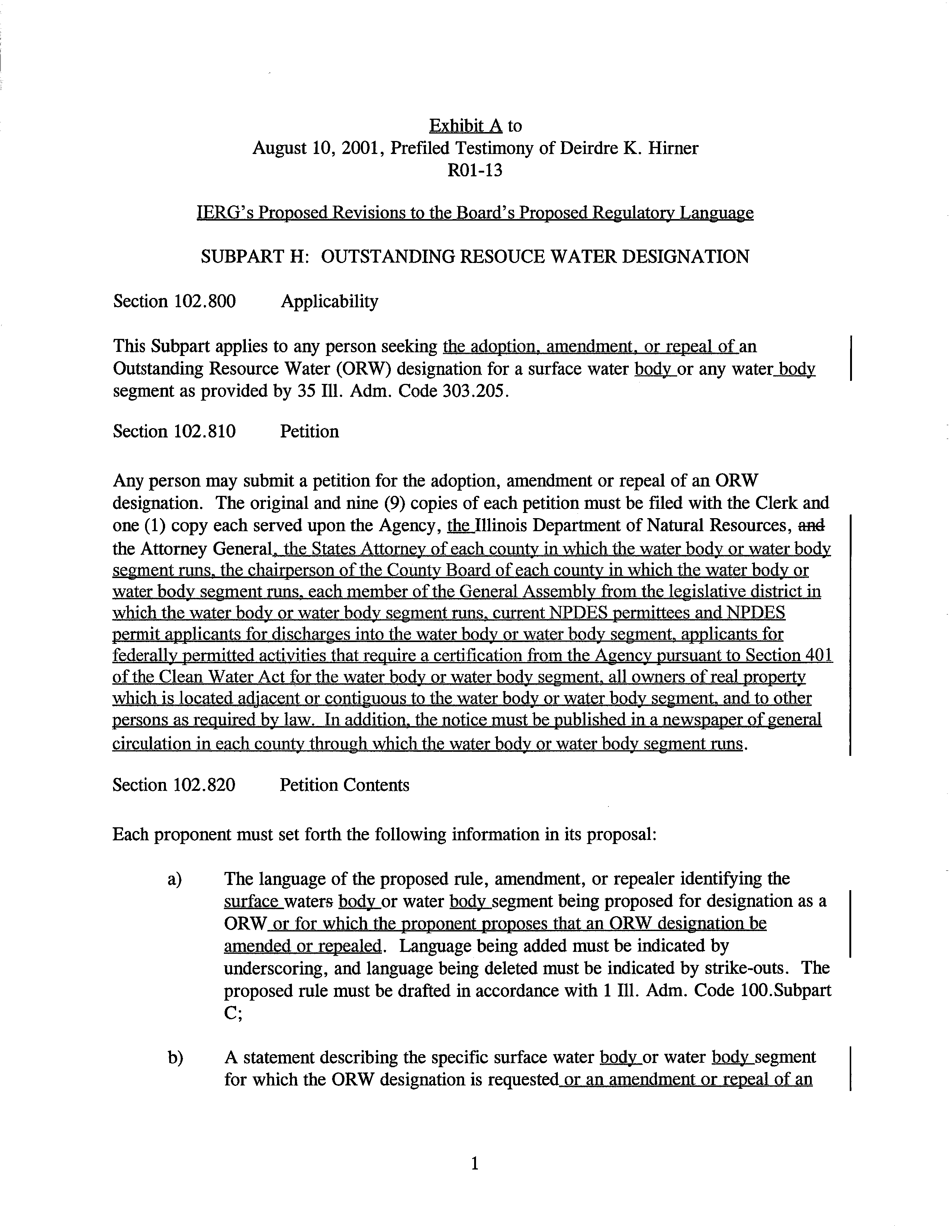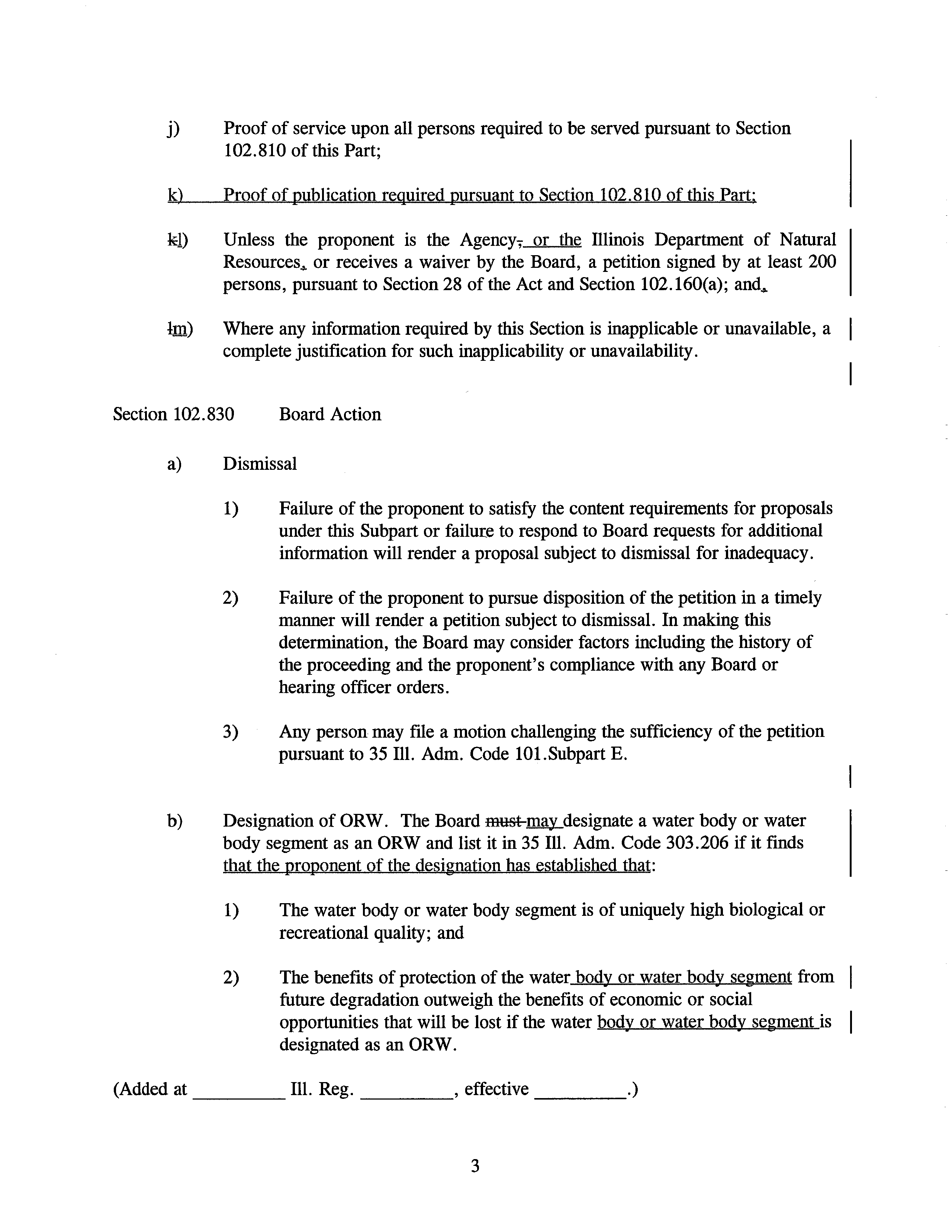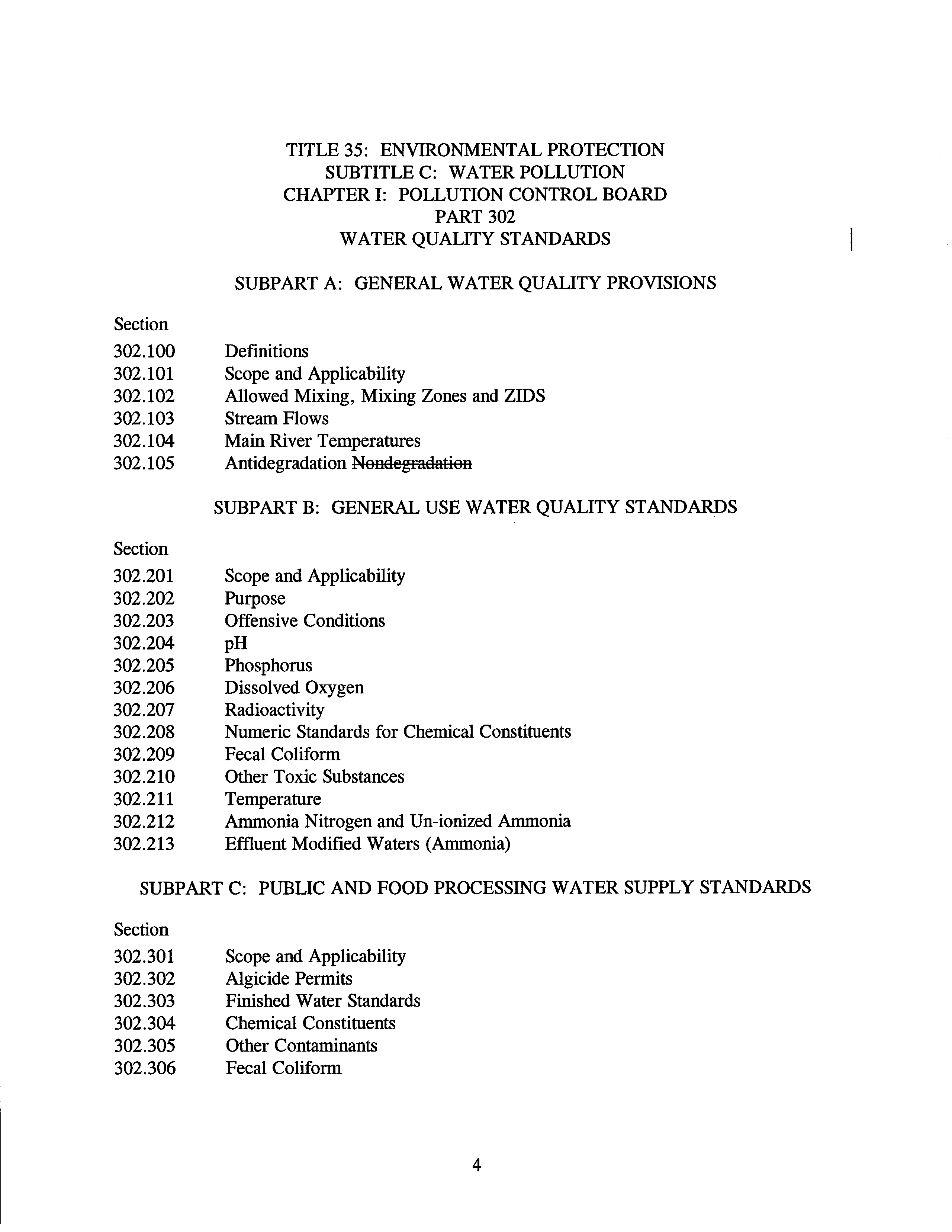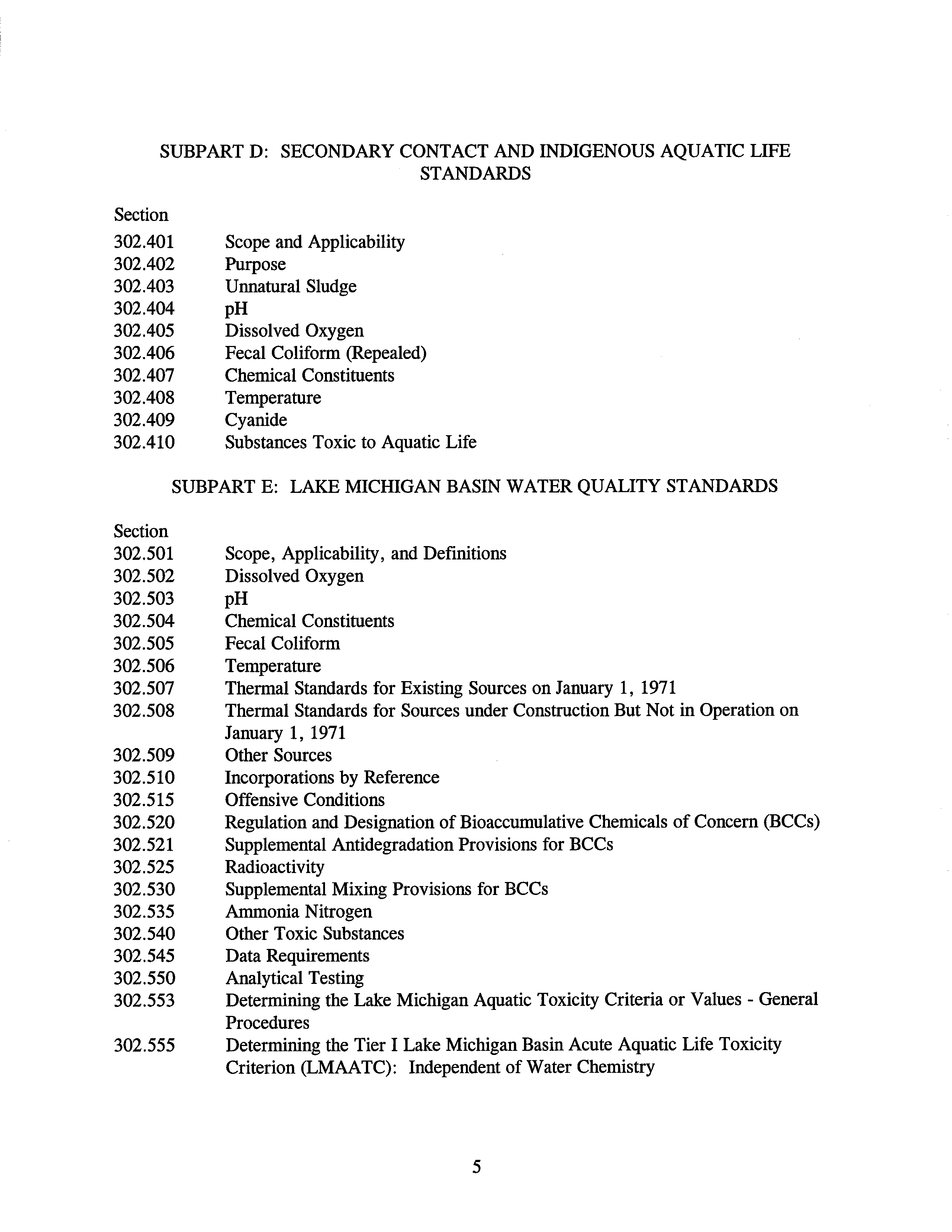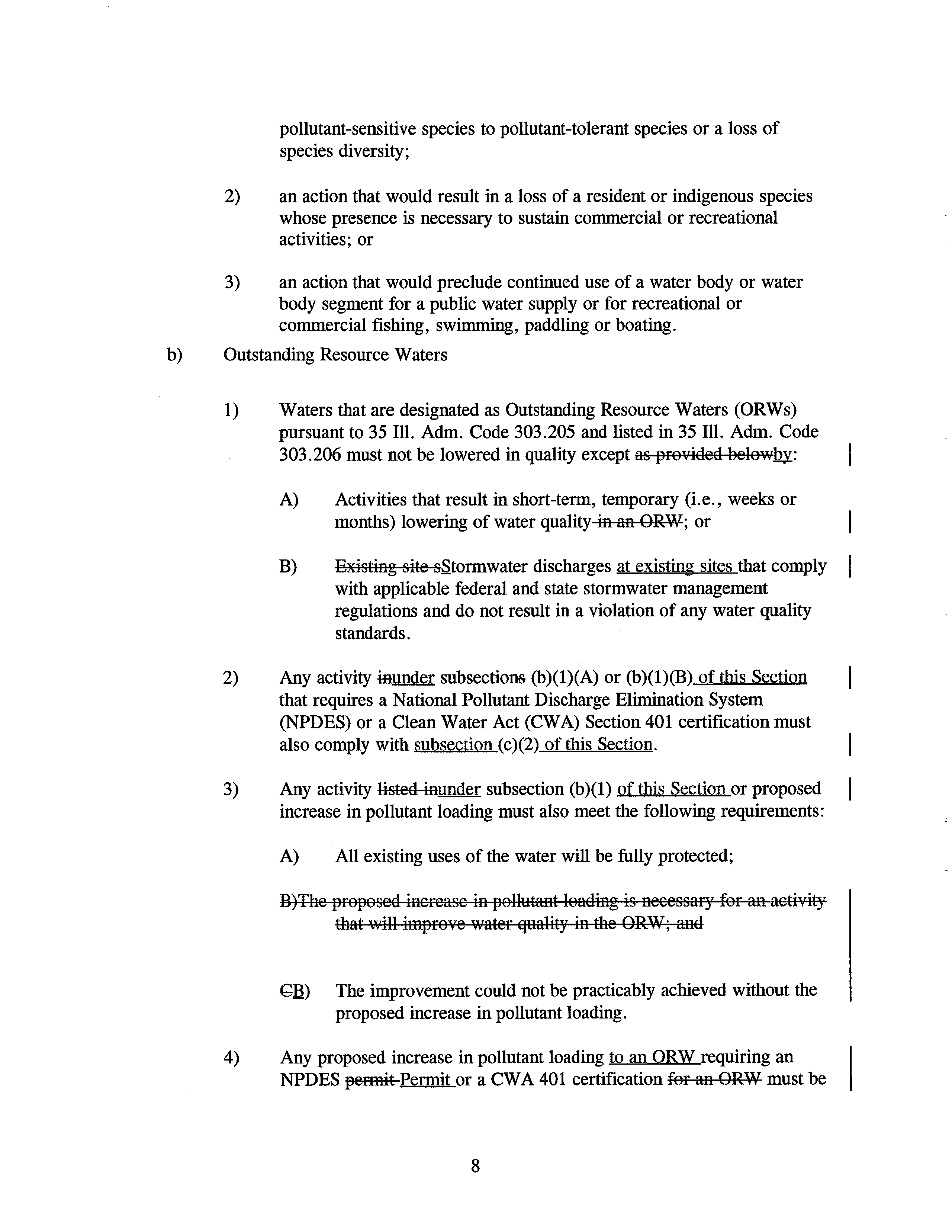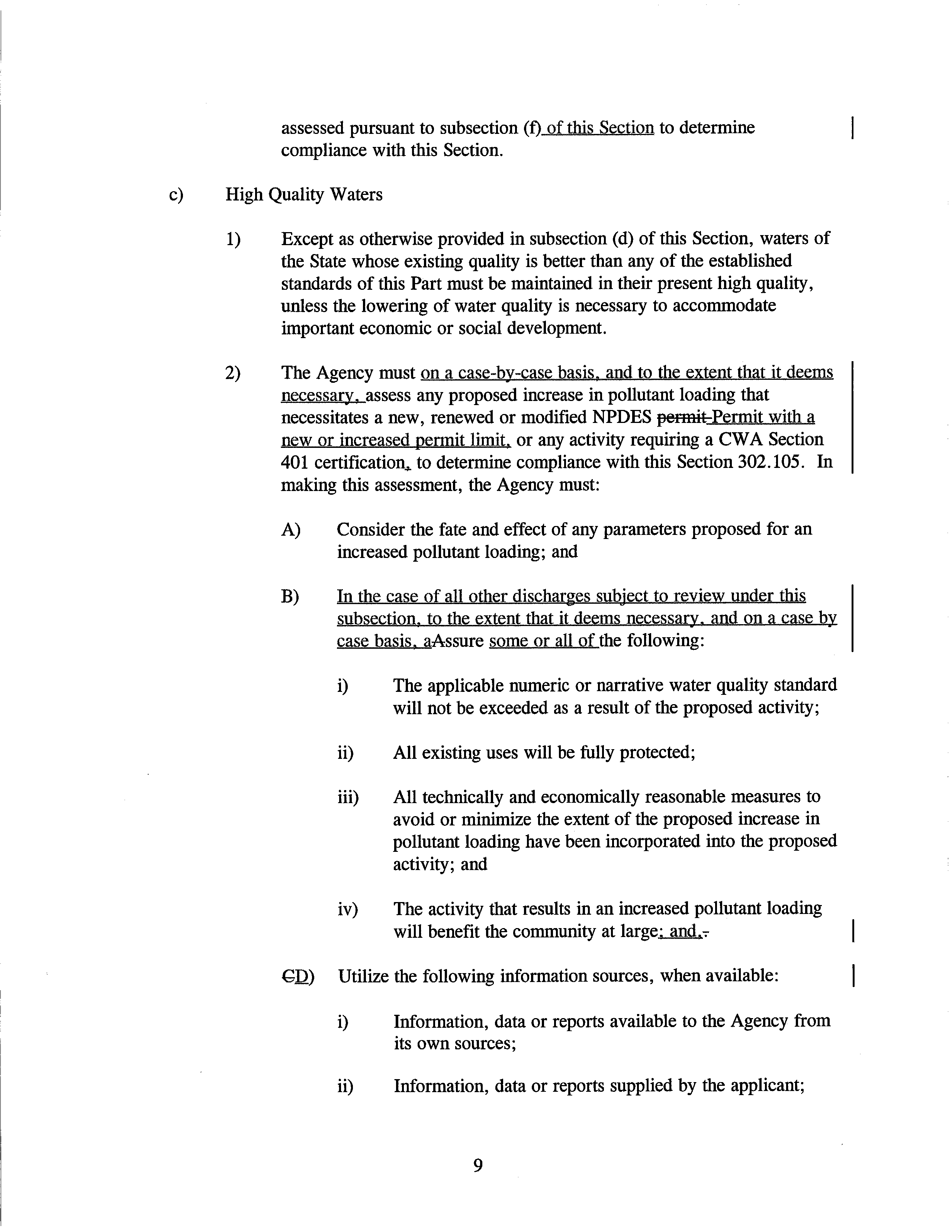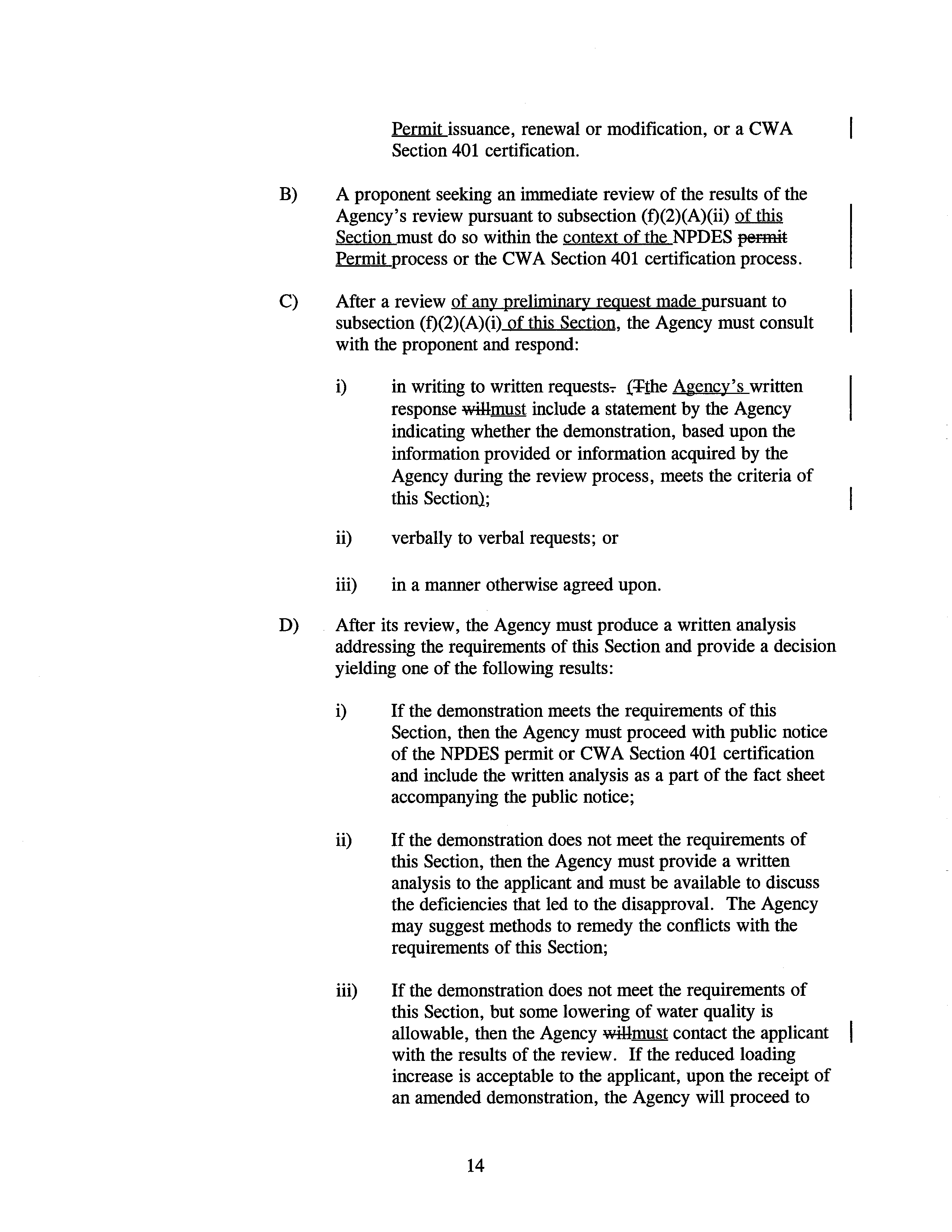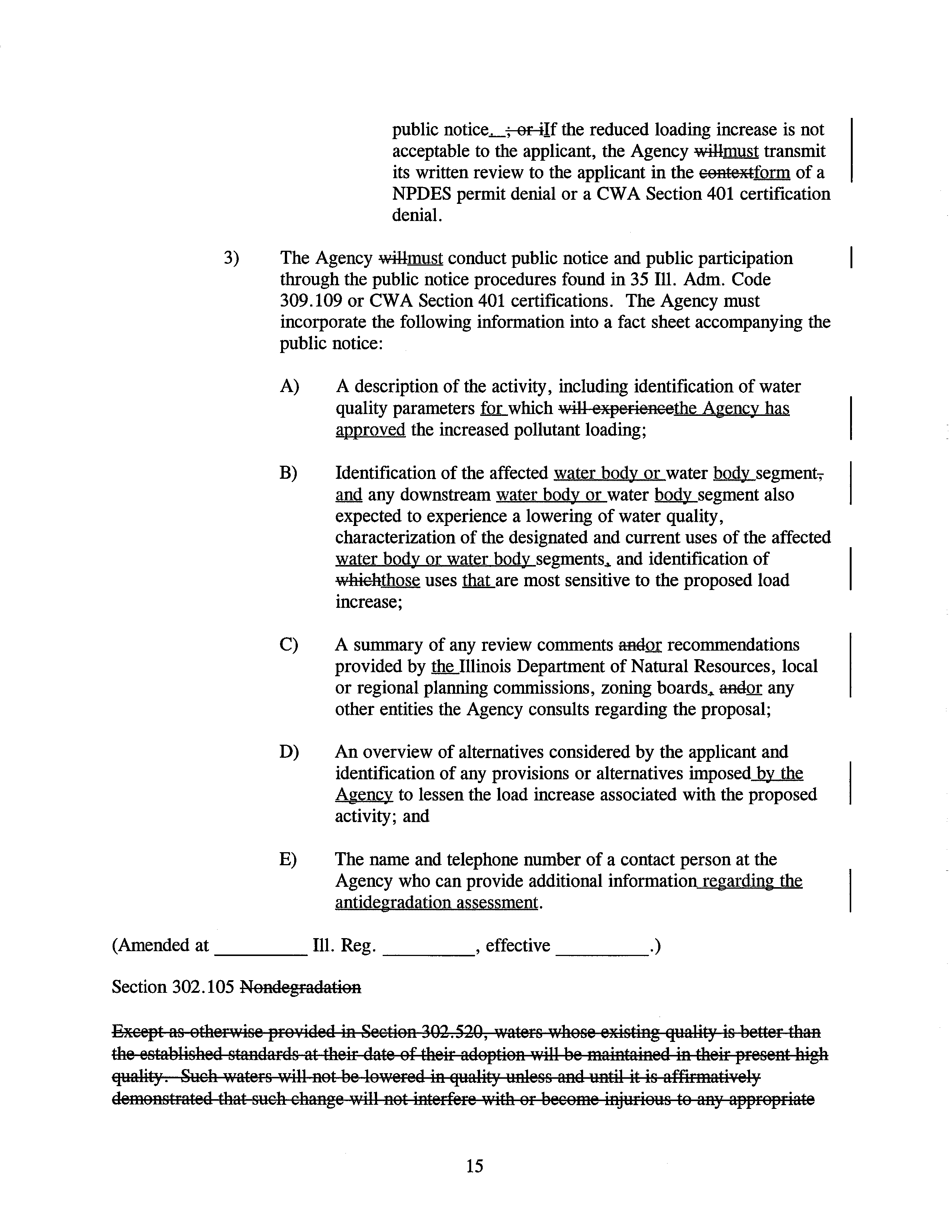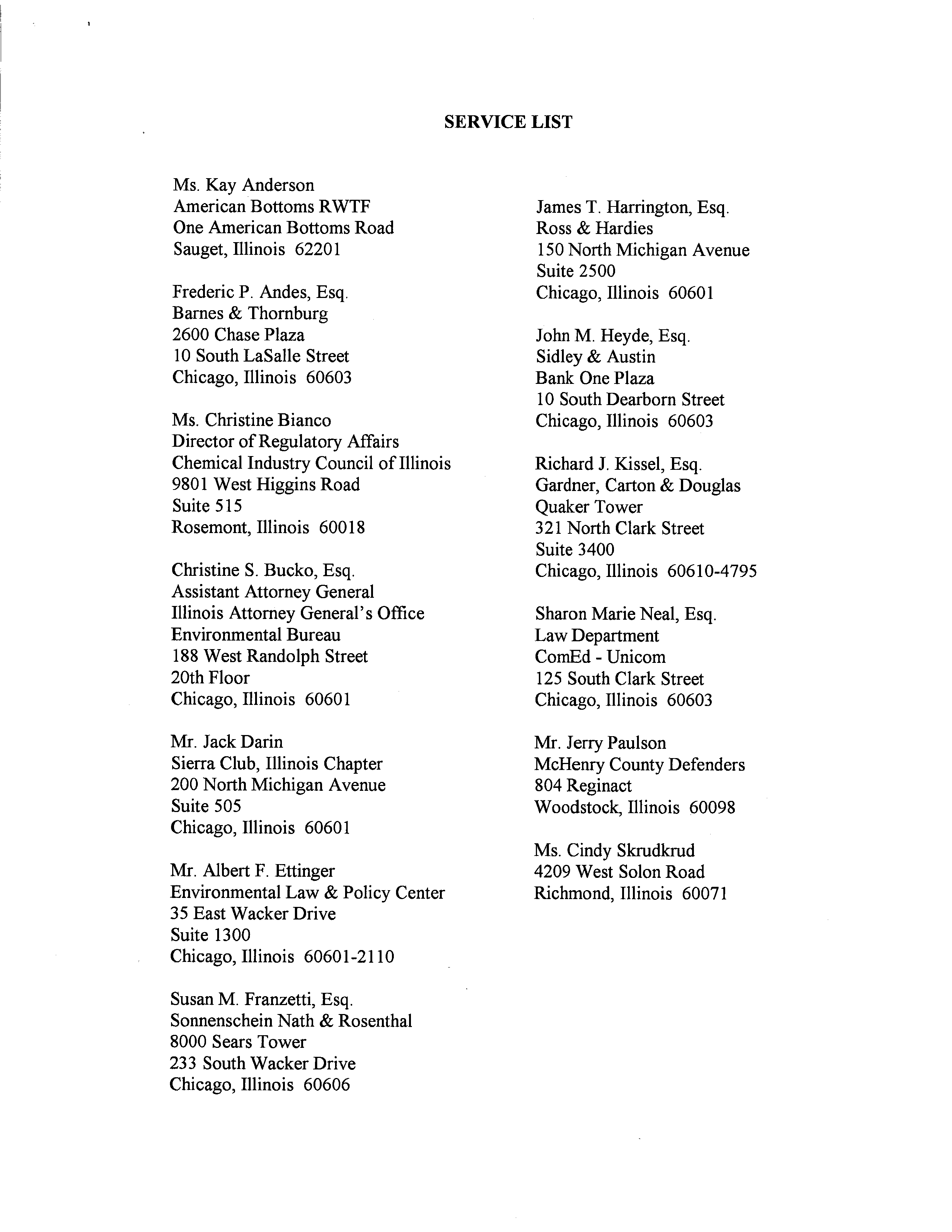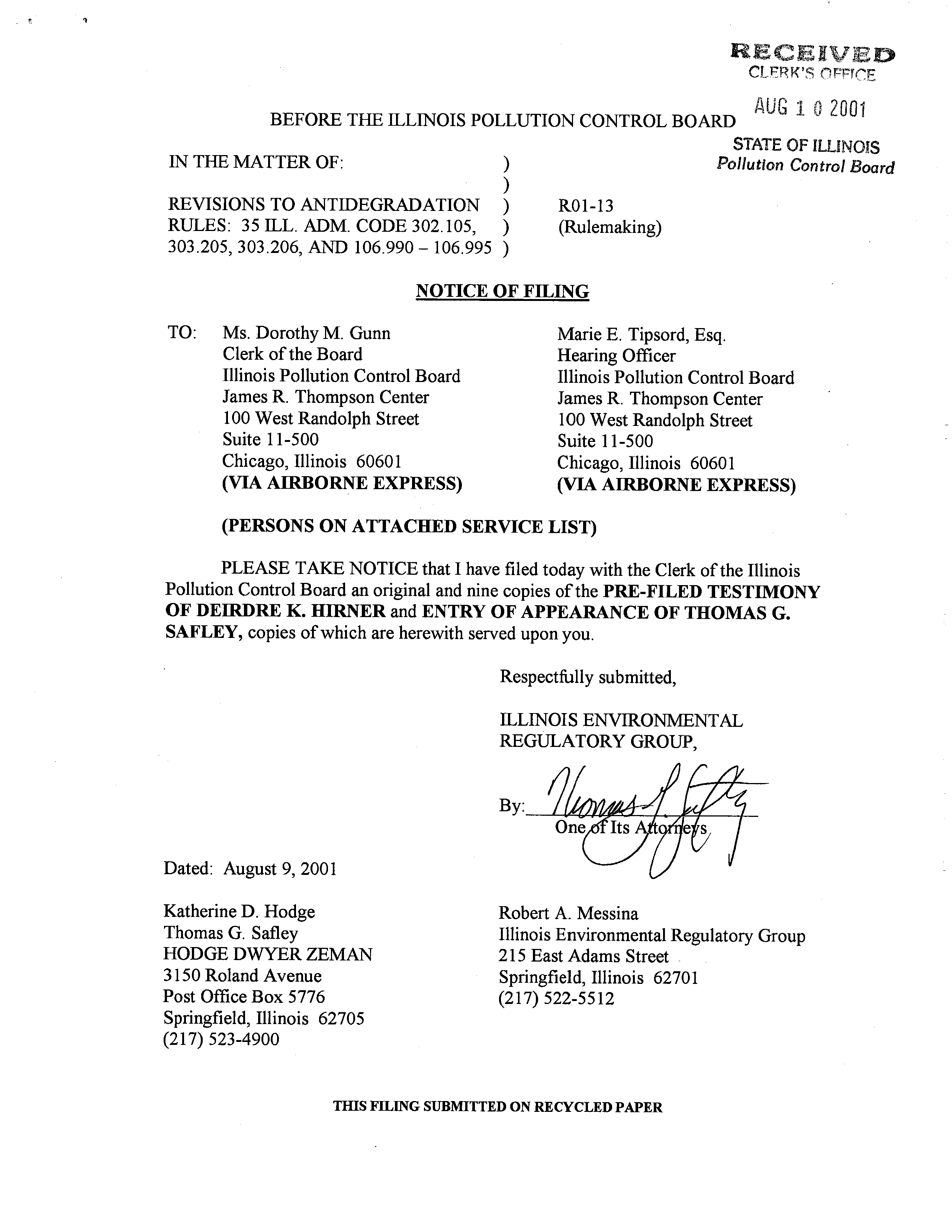
I
R~C~WVi~D
i-~UC
I ~
2001
BEFORE THE ILLINOIS POLLUTION CONTROL BOARD
N THE MATTER OF:
REVISIONS TO ANTIDEGRADATION
RULES: 35 ILL. ADM. CODE 302.105,
303.205, 303.206, AND 106.990
—
106.995
STATE OF ILLINOIS
)
Pollution Control Board
)
)
)
)
RO 1-13
(Rulemaking)
NOTICE OF FILING
TO:
Ms. Dorothy M. Gunn
Clerk ofthe Board
Illinois Pollution Control Board
James R. Thompson Center
100 West Randolph Street
Suite
11-500
Chicago, Illinois 60601
(VIA AIRBORNE EXPRESS)
Marie E. Tipsord, Esq.
Hearing Officer
Illinois Pollution Control Board
James R. Thompson Center
100 West Randolph Street
Suite
11-500
Chicago, Illinois 60601
(VIA AIRBORNE EXPRESS)
(PERSONS ON ATTACHED SERVICE LIST)
PLEASE TAKE NOTICE that I have filed today with the Clerk of the Illinois
Pollution Control Board an original and nine copies ofthe PRE-FILED TESTIMONY
OF DEIIRDRE K. HIRNER and ENTRY OF APPEARANCE OF THOMAS G.
SAFLEY, copies ofwhich are herewith served upon you.
Respectfully submitted,
ILLINOIS ENVII(ONMENTAL
REGULATORY GROUP,
Dated: August 9, 2001
Katherine D. Hodge
Thomas G. Safley
HODGE
DWYER ZEMAN
3150 Roland Avenue
Post
Office Box 5776
Springfield,
Illinois 62705
(217) 523-4900
Robert A. Messina
Illinois Environmental Regulatory Group
215 East Adams Street
Springfield, Illinois 62701
(217) 522-5512
THIS FILING SUBMITTED ON RECYCLED PAPER
BEFORE THE ILLINOIS POLLUTION CONTROL BOAi~J)
IN THE MATTER OF:
REVISIONS TO ANTIDEGRADATION
RULES: 35 ILL. ADM. CODE 302.105,
303.205,
303 .206 and 106.990-106.995
tMJ~ 1
2001
)
)
)
)
)
RO 1-13
STATE OF ILLINOIS
PollutiOn Control Board
(Rulemaking)
ENTRY OF APPEARANCE OF THOMAS G. SAFLEY
NOW COMES THOMAS G. SAFLEY, ofthe law firm ofHODGE DWYER
ZEMAN, and hereby enters his appearance in this matter on behalfofthe Illinois
Environmental Regulatory Group.
Respectfully submitted,
ILLINOIS
ENViRONMENTAL
REGULATORY GROUP,
Dated: August 9, 2001
Katherine D. Hodge
Thomas G. Safley
HODGE DWYER ZEMAN
3150 Roland Avenue
Post Office Box
5776
Springfield, Illinois 62705-5776
(217) 523-4900
TERG:OOltFil/RO1-13 TGS Appearancel
Ct
UI~=. ~
BEFORE THE ILLINOIS POLLUTION CONTROL BOARD
STATE
~
OF
ILL
0
2tJ01
NOIs
IN THE MATTER OF:
)
Pollution Control Board
)
REVISIONS TO ANTIDEGRADATION
)
RO1-13
RULES: 35 ILL. ADM. CODE 302.105,
)
(Rulemaking)
303.205, 303.206,
AND 106.990
—
106.995
)
PRE-FILED TESTIMONY
OF DEIRDRE K. HIRNER
NOW COMES the ILLINOIS ENViRONMENTAL REGULATORY GROUP
(“IERG”), by one ofits attorneys, Katherine D. Hodge ofHODGE DWYER ZEMAN,
and submits the following Pre-Filed Testimony ofDeirdre K. Hirner for presentation at
the August
24, 2001 hearing scheduled in the above-referenced matter:
TESTIMONY OF DEIRDRE K. HIRNER
Good Morning. My name is Deirdre K. Hirner, and I am the Executive Director
of IERG. On behalfofIERG and its member companies, I want to thank the Illinois
Pollution Control Board (“Board”) for the opportunity to present this testimony today.
As the Board is aware, the regulations at issue in this rulemaking have been
developed through a cooperative process involving the Illinois Environmental Protection
Agency (“Agency”), various environmental groups, IERG and other representatives of
the regulated community, and other interested parties. These parties held numerous
meetings over a period oftwo years to develop the proposed regulations, and the Board
held
three hearings to receive information regarding the proposed regulations.
On June 21, 2001, the Board published its Opinion and Order (“Board’s
Opinion”) proposing amendments to the Board’s antidegradation regulations for first
notice. IERG and its members are pleased with many ofthe regulatory provisions
proposed by the Board in its Opinion. IERG and its members are also pleased with many
ofthe statements made by the Board in its Opinion in support of those proposed
regulatory provisions. As set forth below, however, 1IERGbelieves the Board’s proposal
needs additional revisions. IERG has submitted proposed regulatory language reflecting
these
revisions for the Board’s review as Exhibit A to this prefiled testimony.
Again, 1IERG appreciates the opportunity to present this testimony to the Board
today. IERG requests that the Board consider this testimony and IERG’s submission of
proposed revised regulatory language as the Board moves forward with this rulemaking.
I.
THE BOARD SHOULD TAKE FURTHER STEPS TO REACH ITS
STATED GOAL OF FLEXIBILITY EN THE ANTIDEGRADATION
ASSESSMENT PROCESS
One issue to which all parties to this proceeding, as well as the Board, have
agreed
is that all increases in loading to waters ofthe State ofIllinois should not be
subject to the same level of antidegradation review by the Agency. To assure that this
goal was
reached, IIERG proposed several revisions to the Agency’s proposed
antidegradation regulations, including provisions providing for a “significance
determination” for proposed increases, a “de minimis” exemption and other exemptions
from the antidegradation assessment requirement, and other clarifications ofthe
Agency’s proposed regulations.
The Board chose not to include many ofIERG’s proposals in the Board’s first
notice regarding the antidegradation regulations. As set forth below, JIERG respectfully
requests that the Board reconsider
its decision.
A.
IERG’s ProDosed SiEnificance Determination
The Board has properly identified two ofIERG’s intended outcomes in proposing
a significance determination as providing the regulated community some degree of
2
certainty as to how the Agency will implement the antidegradation regulations, and
targeting the Agency’s resources to those loadings that are “truly” significant. Board
Order at
13. Of equal importance to IERG, however, is that all increases in loading not
be subjected to the same depth and degree ofantidegradation review, but rather that the
Agency assess each increase on a “case by case” basis. IERG maintains that, as written,
the
Board’s proposed regulatory language does not afford the Agency such flexibility in
conducting antidegradation assessments.
In rejecting IERG’s proposed significance determination, the Board stated that
IERG’s proposal would require the comparison
of the impact ofpollutant loading on the
quality ofa water body as a whole rather than on a parameter-by-parameter basis. Board
Opinion at
13. While IERG concedes that the language it proposed may be read to so
infer, that was not our intent. IERG concurs with the Board that an antidegradation
assessment should be made on the basis of individual water quality parameters.
The Board also expressed concern that IERG’s proposal would not allow for
public participation in the significance determination process. Id. at 13-14. IIERG
believes that because the Agency performs an antidegradation assessment in the context
ofa review ofan application for an NPDES permit or CWA Section 401 certification, the
public has the opportunity to make its concerns known and to take issue with reliance on
the significance
test at the time the permit is released for public review and comment, as
is the case with any other point of contention as to an NPDES permit or Section 401
certification. However, IERG does acknowledge the Board’s concerns and agrees that
public participation is a most essential aspect of the antidegradation review process.
3
Finally, the Board’s primary concern with IERG’s significance determination
proposal was that it appeared to limit the Agency’s ability to identify and implement
alternatives
that reduce or eliminate loading increases, which the Board saw as the
antidegradation regulations’ main objective. Board Opinion at 14. IERG concedes that
its proposal put forth a tiered approach. 1ERG did not believe, however, that its proposed
significance determination process
precluded the Agency from making recommendations
regarding economically reasonable or no cost alternatives available to reduce or eliminate
proposed increased loadings. TERG anticipated that discussions relative to such matters
would occur in the context ofthe Agency’s implementation procedures now included in
the Board’s proposal at Section 302.105(f), and more specifically under Section
302.
105(f)(2)(A),
which references applicant communication with the Agency during the
planning stage for any load increase.
IIERG continues to maintain that it is not appropriate to subject every increase in
pollutant loading to the same depth and degree ofantidegradation review. As the Board
noted in its Opinion, “[t]he Agency has testified that while all potential increases in
pollutant loading would be subject to antidegradation review on a case-by-case basis, the
level ofreview would depend upon the relative significance ofthe pollutant loadings.”
Board Opinion at 8. IERG submits that its proposed significance determination process
would be one
way to ensure that the Agency has the regulatory authority to conduct
antidegradation reviews on a case-by-case basis dependant upon the characteristics ofthe
individual discharges
and receiving streams at issue.
Nevertheless, IERG is willing to concede its proposed significance determination
process if it can be clearly demonstrated that the Board’s “proposed antidegradation
4
review criteria [otherwise] provide[] the Agency flexibility to perform on a case-by-case
basis the appropriate level ofreview without placing any undue limitations on its ability
to ensure compliance with the proposed antidegradation standard.” Board Opinion at 15
(emphasis added). TERG submits that such flexibility can be achieved through adoption
of a modified de minimis exemption and through other revisions to the Board’s proposed
rules, as follows.
B.
The Board Should Adont a Modified De Minimis Exemntion to the
Antide2radation Assessment Reuuirement
LERG’s proposal for a “de minimis” exemption in the Board’s antidegradation
regulations was motivated by two primary concerns, both ofwhich IERG continues to
believe need to
be addressed: (1) the risk that lengthy, time-consuming antidegradation
reviews will create substantial delay in the process ofissuing and revising NPDES
permits;
and (2) the risk that requiring the Agency to make subjective socioeconomic
decisions as to the value
ofproposed facility projects will introduce substantial
uncertainty into municipal and business planning, even for projects that have little or no
impact on water quality. In response to those concerns, IERG sought a mechanism that
would allow projects that do not have a significant water quality impact not to go through
an antidegradation review. That mechanism was the proposed “de minimis” exemption.
The Board concluded that IERG’s proposed de minimis exemption “may be
helpful in focusing the Agency’s resources on only those increased loadings that pose a
significant threat to water quality.” Board Opinion at 16. Nevertheless, the Board
decided not to include lERG’s de minimis exemption proposal in the Board’s first notice
proposal. See Board Opinion at 15-16. After reviewing the Board’s Opinion, IERG
believes that the Board can address its concerns regarding IERG’s proposal and achieve
5
the goal offlexibility through proposal of a modified, simplified de minimis provision,
the details ofwhich are as follow.
1.
Increases in Bioaccumulatives
The Board’s first concern regarding IERG’s proposed de minimis exemption was
that small increases in bioaccumulative discharges would have been exempt from
antidegradation review, even though small amounts ofthose substances could have
significant impacts. Board Opinion at 16. IERG believes that under its earlier proposal,
the concerns posed by bioaccumulative chemicals of concern (“BCCs”) would have been
taken into account in determining the requirements that would apply, but we understand
the need to make that
concept clearer. Regarding the area ofthe State covered by the
Great Lakes
Initiative requirements, the Board’s rules provide that there is no de minimis
level for BCCs, in other words, that all increased BCC loadings are subject to
antidegradation review (unless covered by another exemption). IERG proposes revising
the
new state-wide rules to be consistent with that requirement, so that even small
increases in BCCs are subject to antidegradation review (including both the review of
alternatives and the “community at large” test). That is, 1ERG proposes adopting a de
minimis exemption here that does not apply to discharges ofBCCs.
2.
Effort Required to Make De Ivlinimis Decisions
The Board’s second concern was that it will take too much effort on the part of
the Agency to determine whether an increased loading exceeds a specified de minimis
level. Board Opinion at 16. IIERG agrees that it would not make sense to have a de
minimis exemption that requires the Agency or anyone else to spend enormous amounts
oftime and effort in making determinations as to whether increases are subject to review.
6
However, LERG believes that the Agency can address this concern by use ofa simple,
“bright line” test and application ofexisting Agency procedures.
IERG’s proposed de minimis exemption would simply provide that increased
loadings of non-BCC chemicals are subject to antidegradation review (again, including
the “community at large” test) if they equal or exceed 10% ofthe available assimilative
capacity ofthe receiving water body, determined at the time that the request for the
increased loading is submitted. In making this decision, the Agency would use the
process that it
already uses to decide whether discharges require permit limits. When
making a permitting determination, the Agency must decide if a proposed discharge has
“reasonable
potential” to cause or contribute to a violation of a water quality standard. 35
Ill. Adm. Code
§
309. 141(h)(4). Ifthere is “reasonable potential,” a limit must be
imposed. 35 Ill. Admin. Code
§
309. 141(h)(4)(B). To make this “reasonable potential”
decision, the Agency applies a calculation method that has been specified by the United
States Environmental Protection Agency (“USEPA”) in its Technical Support Document
for Water Quality-Based Toxics Control (“TSD”) (1991). Id. To use that method, the
Agency must collect and review several items ofinformation, including the background
level ofthe substance in the water body. Using that information and the formulas in
USEPA’s TSD, the Agency reaches a conclusion as to the level of assimilative capacity
that remains in the water body.
It is important to note that this information should always be available to the
Agency
when the antidegradation rules may apply, since those rules are triggered by
increased loadings, which the Agency must evaluate for “reasonable potential.”
Therefore,
whenever the antidegradation assessment requirement may apply, the Agency
7
will have the information needed to readily decide ifthe proposed increase exceeds 10%
ofthe remaining assimilative capacity. In those cases where the information is not
readily available to the Agency for some reason, the burden to provide the necessary data
would be on the applicant. Thus, IIERG’s proposed amended de minimis exemption
would impose no burden on the Agency to generate new data. To clarify this point, it
might be worthwhile to specify in the antidegradation regulations that in making the
“10%” decision, the Agency must use the “reasonable potential” procedures that are
already applied in permitting decisions.
Accordingly, IIERG believes that its proposed de minimis test
—
with the proposed
revisions outlined above
—
provides a workable means by which the Agency can allocate
its resources while protecting the environment. As IERG has noted in its previous
submissions
to the Board, the USEPA has sanctioned the use of a de minimis exemption,
and most other states in the Midwest include a de minimis exemption in their
antidegradation rules. IERG urges the Board to act consistently with the guidance ofthe
USEPA
and the practice ofthese other states and to reconsider its decision not to propose
a
de minimis exemption in Illinois’ antidegradation regulations.
C.
The Board Should Otherwise Amend its Proposal to Provide the
A~encv Flexibility in Conductin2 Antide2radation Assessments
IERG
appreciates and agrees with the Board’s recognition that “all proposed
increases in pollutant loadings should not require the same level ofreview to demonstrate
compliance with the proposed antidegradation standard” and that the antidegradation
“implementation procedures should allow the Agency to decide on a case-specific basis
what level ofreview is appropriate.” First Notice Order and Opinion, page 14. The
Agency has made clear its position that all potential increases in pollutant loading should
8
be subject to the proposed comprehensive review requirements at Section 302.1 05(c)(2),
and that it will perform the reviews based on fate and effect, technology, and economic
considerations. And throughout these proceedings, the Agency has consistently held
“that the complexity ofthe review would be highly dependent upon the nature ofthe
activity, the pollutant and the character ofthe receiving stream.” Board Opinion at 10-
11. This position is consistent with the direction ofthe USEPA that “States and Tribes
should tailor the level ofdetail and documentation in antidegradation reviews, to the
specific circumstances encountered.” 40 C.F.R. Part 132, Appendix E, Section III.
In declining to adopt IERG’s proposed significance determination, the Board
appeared to rely on and agree with the Agency’s assessment that, as written, proposed
Section 302. 105(c)(2) “allows the Agency to decide on a case-specific basis what level of
review is necessary,” and gives the Agency the flexibility it needs to determine the depth
and degree of analysis to be completed for individual antidegradation assessments.
Board Order at 14. TERG respectfully disagrees.
IERG appreciates the Board’s adoption ofproposed Section 302. 105(c)(2)(C),
which expands the universe ofinformation on which the Agency may rely in making an
antidegradation assessment. However, LERG believes that the remaining language of
302.105(c) is drafted in such manner as to place undue restriction on the Agency’s ability
to exercise flexibility in the review process. Accordingly, IERG offers the following
revision to the Board’s proposed Section 302. 105(c)(2) in an effort to ensure the Agency
discretion to conduct an antidegradation review and assessment for each permit
application on a case-by-case basis:
The Agency must on a case-by-case basis, and to the extent that it deems
necessary, assess any proposed increase in pollutant loading that
9
necessitates a new, renewed or modified NPDES Permit with a new or
increased permit limit’, or any activity requiring a CWA Section 401
certification~ to determine compliance with this Section 302.105. In
making this assessment, the Agency must:
**
*
B)
To the extent that it deems necessary. and on a case by case
basis, Aassure some or all ofthe following...
IIERG’s Proposed Revised Section 302. 105(c)(2)
(~
Exhibit A)
The Board’s adoption ofthis proposed clarification and similar language in
proposed Section 302. 105(f)(1)
(~
Exhibit A) will give the regulated community a
degree
of comfort with conceding the need for specific language regarding a significance
determination process. Additionally, TERG strongly urges the Board to clearly articulate,
in its Final Opinion and Order in this matter, that the antidegradation regulations have
been developed to
allow the Agency the flexibility necessary to establish the level of
review required to demonstrate compliance with the antidegradation standard on a case-
by-case basis rather than to provide that every proposed increase in loading must undergo
a comprehensive antidegradation assessment.
II.
THE BOARD SHOULD ADOPT FURTHER EXEMPTIONS TO THE
ANTIDEGRADATION ASSESSMENT REOUIREMENT
In addition to the significance test and de minimis exemption discussed above,
ERG proposed several exemptions to the antidegradation assessment requirement in
addition to those exemptions proposed by the Agency. As ERG has maintained
consistently throughout the process ofdevelopment of the antidegradation regulations,
exemptions to the antidegradation review requirements allow the Agency to avoid the
See discussion of this proposed amendment to the Board’s proposed Section 302. 105(c)(2) below.
10
review ofpermits that have virtually no environmental impact, and, thus, to expend its
resources where they are truly needed. TERG commends the Board for supporting the
addition ofan exemption for those changes to a new permit limitation that do not result in
an actual increase of a pollutant loading. (Board’s proposed Section 302. 105(d)(7)).
However, IIERG believes the antidegradation review process would further benefit if the
Board would reconsider adopting the following exemptions proposed by IERG in its
Post-Hearing
Comments, dated March 19, 2001.
A.
Non-Contact Coolina Water Dischar2es (Board Pronosed Section
302. l05(dfl5Y~
The Board’s proposed Section 302. 105(d)(5) provides an exemption from the
antidegradation assessment requirement
for discharges ofnoncontact cooling water
“without additives.” IERG suggested that the words “without additives” be removed
from this exemption and replaced with a reference to Agency approved additives.
JERG’s rationale forthis suggestion was that the Agency would have determined that an
additive had no potential to adversely impact water quality, thus making an
antidegradation assessment at the time it approved the additive.
The Agency stated its position regarding this suggestion as follows:
the addition ofadditives to a discharge orthe change in additives should
be subject to an antidegradation assessment.
...
The Illinois
s
position is that there may be benefit in reviewing the additive to determine
if it is the best additive and whether there are toxic ramifications in the
receiving stream
forthat additive.
Agency Closing Comments, filed March 20, 2001 (“Agency Closing Comments”), at 13.
IERG believes that this argument against an exemption for increases in discharges of
cooling water containing Agency approved additives is essentially the same as IERG’s
11
argument in favor ofthe exemption. IERG does not propose that the addition ofnew
additives to a discharge or a change in the additives in a discharge be exempt from
antidegradation review. Rather, TERG proposes that increases in cooling water
discharges containing an additive that the Agency has already approved be exempt from
further review. TERG maintains that, once an additive has been approved, a new or
increased discharge of non-contact cooling water containing that approved additive
should not be subject to further antidegradation review. IERGtherefore respectfully
requests the Board’s reconsideration of this exemption. Ifthe Board decides again not to
include this exemption
in its first notice, IIERG respectfully requests that the Board
explain the basis for rejecting the exemption.
B.
Stormwater Discharaes (IERG’s ProDosed Section 3O2.1O5(d~(8)
IERG also urgesthe Board to reconsider adoption
ofIERG’s proposed exemption
to cover instances where site development or construction could increase stormwater on a
site regulated by an industrial facility’s individual NPDES permit through the facility’s
Stormwater Pollution Prevention Plan (SWPPP). IIERG maintains that plant modification
or construction activity would have been taken into account at the time the SWPPP was
initially developed. IERG believes inclusion ofthe following exemption would avoid the
need
for duplicative review each time changes are made on-site:
Site stormwater discharges covered by a Stormwater Pollution Prevention
Plan, as required in an individual NPDES permit, provided that the
discharge will not
cause or contribute to a violation of Illinois water
quality standards.
IERG’s proposed Section 302.
105(d)(8).
In its Closing Comments, the Agency stated its position that “it would need to
make
an individual assessment of an increase[d] loading caused by an additional service
12
area or increased stormwater.” Agency Closing Comments at 14. However, in response
to
questions at the November 17, 2000, Hearing held in this matter, the Agency’s witness
Toby Freverttestified that if a permittee adheres to the management requirements for
stormwater
in a permit as new or expanded facilities are added, no additional
authorization is needed from the Agency. November 17, 2000 Hearing Transcript at 199-
200. IERG believes these conflicting statements regarding the trigger for stormwater
review can be addressed by its proposed exemption.
C.
Dischar2es Authorized
by the Board
or a Court (IERG’s Proposed
Section 3O2.lO5(d~(9V~
IERG
also recommended two exemptions to the antidegradation assessment
requirement for discharges authorized outside normal permitting procedures, namely
discharges authorized by a site-specific regulation, adjusted standard, orvariance issued
by the Board, or by a Consent Order, Consent Decree, or other Order entered by a Court
of competentjurisdiction. LERG’s proposed Sections 302. 105(d)(10) and (11), now
IERG’s proposed Section 302.
105(d)(9).
Regarding discharges authorized by the Board,
the Agency has indicated that it will not nullify any provision of a Board Order through
the application
ofthe antidegradation regulations, and that a Board Order itself
constitutes
compliance with or exemption from antidegradation review requirements.
Agency Memorandum dated June 14, 2000, Attachment 5, paragraph 6. IERG assumes
that, by this statement, the Agency means that if the Board has authorized a discharge
through a site-specific regulation, an adjusted standard, or a variance, that discharge is
not subject to a further antidegradation assessment by the Agency under the regulations at
issue here. IERG agrees with the Agency that this should be the case, and urges the
Board to adopt an exemption so providing.
13
Regarding discharges authorized by the Court, IERG notes the Agency has no
authority to review a Court Order authorizing a discharge. Further, IERG notes that the
Agency’s comments just discussed regarding the approval by the Board of-a discharge
apply equally to approvals by a Court of a discharge.
Accordingly, in order to avoid any potential ambiguity, IERG recommends
explicitly stating the following exemption to avoid unnecessary uncertainty:
Permits incorporating discharges authorized by a site-specific regulation,
adjusted standard, or variance issued by the Board, or by a Consent Order,
Consent Decree, or other Order entered by a court ofcompetent
jurisdiction.
IERG’s proposed
Section 302. 105(d)(9)
~
Exhibit A). IERG believes these proposed
exemptions cover categories of activities that the Agency has proposed that the Board
determine
comply with the substance and intent of the antidegradation standard, and for
which performance of individual demonstrations is not necessary. Under IERG’s
proposed exemption, these activities are not exempt from the antidegradation standard;
rather they “are essentially subject to similar types of reviews under other [authority], and
a separate demonstration would constitute an unnecessary and burdensome redundancy.”
Pre-filed Testimony of Toby Frevert dated October 27, 2000, at 6.
III.
THE BOARD SHOULD CLARIFY WHICH INCREASES IN LOADING
ARE SUBJECT TO AN ANTIDEGRADATION ASSESSMENT
IIERG
also proposed that the Board clarify its proposed regulations to make clear
that the antidegradation assessment requirement applies only to increases in pollutant
loading that necessitate a new, renewed, or modified NPDES Permit with a new or
14
increased permit limit. Prefiled Testimony ofD.K. Hirner, Jan. 18, 2001, at
92~
The
Board included the provision proposed by IERG in the Board’s proposed Section
302.
105(f)(1)
regarding the procedures by which the Agency is to conduct
antidegradation assessments. The Board did not include this provision in its proposed
Section 302.
105(c)(2),
however.
This omission appears to be a typographical error. First, the Board revised the
Agency’s
proposed Section 302.
105(c)(2)
in all other respects to be consistent with the
Board’s Section 302.
105(f)(1).
Second, it is IiERG’s understanding that this clarification
accurately reflects the Agency’s intent. See November 17, 2000, Hearing Transcript at
45,11. 1-2 (Testimony ofAgency Witness Toby Frevert). Third, requiring such a review
would be duplicative, as the Agency will have already conducted an antidegradation
review ofthe increased level ofdischarge when it initially issued the NPDES Permit.
Accordingly, IERG has revised the Board’s proposed Section 302. 105(c)(2) in IiERG’s
Exhibit A to contain this provision. IERG respectfully asks that the Board so amend its
proposed 302.
105(c)(2)
in second notice as well.
IV.
IERG THANKS THE BOARD FOR INCLUDING THE AGENCY’S
PROCEDURES FOR CONDUCTING ANTIDEGRADATION
ASSESSMENTS IN THE BOARD’S PROPOSED REGULATIONS
One of IERG’ s
previous suggestions to the Board in this matter was to include the
Agency’s rules regarding how it conducts antidegradation assessments in the Board’s
2
The application ofthis clarification is demonstrated by the following example. Aperson with an NPDES
Permit authorizing adischarge aparticular contaminant at a level of
5
micrograms/liter (~g/l) is actually
discharging at alevel of 3 ~ig/l,and wishes to increase the discharge to 4 ~.ig/l.This increase would require
a modified NPDES Permit to include a new monitoring requirement, but no discharge atan unapproved
level would occur, and no “new or increased permit limit” would be included in the modified NPDES
Permit. Accordingly, the person would not be required to go through anotherantidegradation-assessment.
15
antidegradation regulations. IERG’s March 19, 2001, Post-Hearing Comments at 9-10.
The Board agreed with this suggestion and has included the Agency’s rules as the
Board’s proposed Section 302.105(f). Board Opinion at 34-37. IERG thanks the Board
for
doing so, and has proposed only minor, non-substantive revisions to the Board’s
proposed Section 302.105(f). See Exhibit A
V.
THE BOARD SHOULD AMEND ITS PROPOSED REGULATIONS
REGARDING OUTSTANDING RESOURCE WATER DESIGNATIONS
Another major issue in this rulemaking has been the process by which the
designation ofOutstanding Resource Waters (“ORWs”) will take place. In general,
ERG proposed two changes to the Agency’s proposal regarding the designation of
ORWs: first, ERG proposed that the designation of ORWs take place through an
adjusted standard or other adjudicatory proceeding; second, ERG proposed that the
Board clarify the process by which ORW designations will take place.
In its Opinion, the Board proposed that ORW designations be created, amended~
and repealed through rulemaking proceedings rather than through adjudicatory
proceedings. Forthe reasons stated to the Board previously, ERG still believes that it
would be advantageous to utilize an adjudicatory proceeding to consider ORW
designations. However, ERG acknowledges the Board’s concerns regarding the use of
an adjudicatory proceeding and is willing to concede its request for use ofan adjudicatory
proceeding.
Ifa rulemaking proceeding is to be used to consider petitions regarding ORW
designations, however, ERG feels that the Board must address two issues. First, ERG is
particularly concerned with the Board’s decision to limit the notice required by a person
seeking the designation ofan ORW or the amendment orrepeal ofsuch a designation.
16
As the Board is aware, the Agency’s witness,
Mr.
Toby Frevert, acknowledged in the first
hearing held in this matter that:
the ramifications of[a] decision [to designate a water body as an ORW]
are
fundamentally more significant than the ramifications ofa typical
adjusted
standard or even a statewide standard.
November 17, 2000, Hearing Transcript at 88, 11. 10-14. In light ofthe significance of
the ramifications ofa decision to designate a water body as an ORW, Mr. Frevert
concluded that there must be “an obligation to disseminate adequate information
[regarding a proposal to designate an ORWI to start the process and [to assure] that
potentially [a]ffected property owners and other citizens have adequate notice” of a
proposal to designate an ORW Id p. 88, 1. 22 to 89, 1. 1.
In accordance with this testimony, the Agency proposed that notice regarding
proposals to
designate, modify, or appeal ORWs be provided to not oniy the Agency, the
Illinois Department ofNatural Resources (“LDINR”), and the Attorney General, but also
to the States Afforney, County Board, and Legislators for the area through which the
water body at issue runs, and to NPDES Permit holders and permit applicants for the
water body. Agency’s Proposed Section 106.992. IiERG proposed that notice also be
provided to property owners who would be affected by the ORW designation. See
IERG’s proposed Section 303.205(a)(12). Inthe case ofa water body segment, this
would include not only those owners ofproperty located adjacent to the water body
segment at issue, but also those who may be impacted because oftheir location in the
drainage area ofthat water body segment.
The Board declined to adopt the Agency or IERG’s recommendations, instead
providing
in its proposed Section 102.8 10 that notice need only be served on the Agency,
17
the IDNR, and the Attorney General. Board’s Opinion at
25.
In support ofthis decision,
the Board stated that publication ofthe proposal in the
Illinois Register
and on the
Board’s website, and holding a local hearing regarding the proposal, would provide
adequate notice to the public ofthe proposed ORW designation, and further that “various
interest groups already regularly scan [the Illinois Registeri for notices that may impact
their constituents.” Board’s Opinion at 23.
1IERG must respectfully disagree with this decision by the Board. It may be that
the parties participating in this rulemaking will be aware offuture proposals to designate
water bodies as ORWs, or to modify or repeal such designations. Not all affected parties
will be aware ofsuch proposals, however. For example, consider that no representatives
of agricultural interests in the State ofIllinois are participating in this proceeding. We
would imagine that the designation ofa water body as an ORW would have a profound
impact on persons who produce agricultural products on land that borders that water
body. LERG can only assume that groups representing the interests ofsuch persons are
unaware ofthis rulemaking or its potential impact. Therefore, no reason exists to believe
that these entities will notifV their affected members offuture proceedings to designate
water bodies as ORWs. Further, property owners who do not belong to groups that
represent special environmental, business or industrial interests will have no way of
learning ofsuch proceedings except through the
Illinois Register
or the Board’s website.
1ERG questions whether it is reasonable to assume that individual property owners are
aware ofthose resources or scan them regularly to ascertain whether they will be affected
by any rulemakings before the Board.
18
Accordingly, IERG respectfully requests that the Board reconsider its decision not
to require notice ofa proposal to designate, modify, or repeal ORWs to the parties
identified
by the Agency and IERG, or to require publication of such notices in the area
that
would be affected by the proposal. In support ofthis request, IERG notes that the
Board has provided that notice ofa petition to designate a special resource groundwater
must be given in a newspaper ofgeneral circulation in the area that would be affected by
the designation. 35 Ill. Admin. Code
§§
620.260 (providing that special resource
groundwaters
shall be designated through the adjusted standard process), 104.408(a)
(requiring notice in a newspaper ofgeneral circulation in the area likely to be affected by
an adjusted standard). The Agency’s witness, Mr. Toby Frevert, has testified that it is
his understanding that the limitations associated with the designation ofan ORW “may
be even more
restrictive.
..
than the limitations placed on groundwaters” when they are
designated as
“special resource groundwaters.” November 17, 2000, Hearing Transcript,
at 94, 11. 9-12. Accordingly, the notice proposed by the Agency and IERG is justified.
It is also instructive that the notice proposed by the Agency and IERG is almost
identical to the community outreach requirement proposed by Citizens for a Better
Environment (“CBE”)
in its Petition to Adopt 35 Ill. Admin. Code Section 740.800, filed
January
26, 2001, and pending before the Board as Rulemaking RO1-29, which IERG is
on record as supporting. CBE’s proposed Section 740.8 15 provides that a person
proceeding under the Illinois Site Remediation Program (“SRP”) must notify “interested
persons, public officials and organizations” before filing an SRP application “for a
remediation site
intended for future use as a school, public park, or playground.” Id. at 2.
In addition, notice would have to be filed “in at least one newspaper of general
19
circulation in the county where the remediation site is located.” Id. As discussed above,
JERG urges the Board to adopt the same notification requirements for ORWs.
Second, IERG is concerned that the Board’s first notice does not make clear that
the proponent has the burden in a proceeding considering a proposal to create, amend, or
repeal an ORW designation. As IERG noted in its March 19, 2001 post-hearing
comments, given the significant restrictions on land use that an ORW designation would
impose, the burden to establish that the designation is warranted must be clearly placed
on the proponent ofthe designation. IERG’s March 19, 2001, Post-Hearing Comments at
18-20. Further, patently placing the burden on the proponent would make clear to the
proponent what it must
establish to support the designation and would enable the Board
to judge whether the proponent has carried its burden. Id
Accordingly, IIERG proposes the following modification to the Board’s proposed
Section 102.830(b):
Designation of ORW. The Board must designate a water body or water
body segment as an ORW and list it in 35 Ill. Adm. Code 303 .206 if it
finds that the proponent ofthe designation has established [specified
criteria.]
This clarification will assure the regulated community that while it has conceded its
request that the Board to utilize an adjudicatory proceeding to consider ORW
designations, the proponent of an ORW designation will still have the burden to establish
that such a designation is justified, and thus, ORW designations will not occur without a
showing that they are justified.
VI.
REOUESTS FOR CLARIFICATION
Finally, on review ofthe Board’s proposed language, IIERG believes that certain
provisions ofthe Board’s proposed regulations require clarification to aid industry in
20
achieving full compliance with environmental laws and regulations. TERG does not
believe the following sections raise substantive concerns, but as drafted, they create some
confusion.
A.
Section 302.105(bMlflB
This section provides an exception for existing site stormwater discharges that
comply with regulations and which do not violate water quality standards. LERG
presumes this provision was included to allow the continued operation offacilities that
were sited prior to the time a water segment was designated an ORW. Therefore, we
recommend the following language clarification:
B)
E*isting-site-s Stormwater discharges at existing sites that comply
with applicable federal and state stormwater management
regulations and do not result in a violation ofany water quality
standards.
See Exhibit A
B.
Section 3O2.1O5(b)(3~(B
This section requires that the short term temporary activities and the stormwater
discharges allowed under
Section 302. 105(b)(1) may be allowed only if they also are
“necessary for an activity that will improve water quality in the ORW.” This provision
does not make sense. According to Mr. Frevert, the section was structured to parallel
federal
guidance to allow load increases in an ORW only in very few and very limited
circumstances, those being the ones identified in Section 302. 105(b)(1). November 17,
2000, Hearing Transcript at 87. Placing the added burden ofrequiring that the exceptions
also improve water quality practically assures that these exceptions will never be
available for use by a facility located on an ORW. IIERG recommends that Section
302.105(b)(3)(B) be deleted.
21
C.
Section 3O2.lO5(d~(6~
This section creates an exemption from further antidegradation review for those
discharges permitted under a “current” general NPDES permit. JERG finds use ofthe
word “current” confusing, as it could be interpreted to mean a general permit currently in
the possession ofthe permittee, orthe Agency’s general permit. When questioned
regarding this issue at hearing, Mr. Frevert indicated that reference is to “a permit valid at
that time.”
November 17, 2000, Hearing Transcript at 198. When queried further as to
whether
he meant that the Agency’s general permit was current or that the Agency’s
permit currently applied to the discharge, Mr. Frevert stated: “it would have to be both.
It doesn’t apply to a discharge that has expired.” Id. at 197-198. Mr. Frevert has
indicated that the
Agency conducts a generic antidegradation review when drafting a
general permit. Id. at 183-84. Therefore, IERG presumes that the Board means this
exemption to apply to those
discharges forwhich a general permit has been adopted by
the Agency and is in effect. Accordingly, IERG recommends deleting the word “current”
from this exemption. See Exhibit A
D.
Section 3O2.1O5(d~(6~
This section also includes
a
provision requiring the Agency to “assure that
individual permits or
certification are required prior to all new pollutant loadings or
hydrological modifications that necessitate a new, renewed, or modified NPDES Permit
or CWA Section 401 certification that affect waters ofparticular biological significance.”
Board’s proposed Section 302. 105(d)(6). IIERG is uncertain ofthe meaning ofthis
provision, as it was never discussed during the course ofthe Agency’s work group
meetings. IERG also is uncertain ofthe definition of the phrase “waters ofparticular
22
biological significance,” unless, as we believe, this is a reference to outstanding resource
waters. LERG respectfully requests that the Board clarify these issues.
E.
Section 302.105(f)(1WF
This section provides that a permit application subject to an antidegradation
demonstration
must include, if necessary, “[a]ny ofthe information sources identified in
subsection 302.
105(d)(3).”
Board’s Proposed Section 302.
105(f)(1)(F)
(emphasis
added). Subsection 302.
105(d)(3)
addresses an exemption from the antidegradation
assessment requirement for response actions under environmental laws. See Board
Opinion at 33-34. Accordingly, this reference appears to be a typographical error. IERG
assumes that the Board meant to refer to Subsection 302.
105(c)(2)(C),
and has so
changed this reference in IERG’s proposed revisions to the Board’s proposed regulatory
language attached hereto as Exhibit A
LERG appreciates the
opportunity to bring these issues to the attention ofthe
Board. We look forward to the Board’s insight in clarifying these matters. IIERG has
also proposed some other minor, non-substantive revisions to the Board’s proposed
regulatory language meant to clarify what IIERG understands to be the Board’s intent in
that language. See Exhibit A
23
VII.
CONCLUSION
Thank you for the opportunity to testify today. I would be pleased to answer any
questions the Board may have at this time.
IERG
reserves the right to supplement or modify this pre-filed testimony.
Respectfully submitted,
ILLINOIS
ENVIRONMENTAL
REGULATORY GROUP,
By:
Katherine D. Hodge
Dated: August 9, 2001
Katherine D. Hodge
Thomas G. Safley
HODGE
DWYER ZEMAN
3150 Roland Avenue
Post
Office Box 5776
Springfield, Illinois 62705-5776
(217)
523-4900
Robert A. Messina
Illinois Environmental Regulatory Group
215 East Adams Street
Springfield, Illinois 62701
IERG:OO1/R Dockets/Fil/RO1-13/Pre-filed Testimony of D.
K.
Himer First Notice
24
Exhibit A to
August 10, 2001, Prefiled Testimony of Deirdre K. Hirner
ROl-
13
IERG’s Proposed Revisions to the Board’s Proposed Regulatory Language
SUBPART H: OUTSTANDING RESOUCE WATER DESIGNATION
Section 102.800
Applicability
This Subpart applies to any person seeking the adoption, amendment. or repeal of an
Outstanding Resource Water (ORW)
designation for a surface water body or any water body
segment as provided by 35 Ill. Adm. Code 303.205.
Section 102.810
Petition
Any person may submit a petition for the adoption, amendment or repeal of an ORW
designation. The original and nine (9) copies of each petition must be filed with the Clerk and
one (1) copy each served upon the Agency, the Illinois Department of Natural Resources, and
the
Attorney General. the States Attorney of each county in which the water body or water body
segment runs. the chairperson ofthe County Board ofeach county in which the water body or
water body segment runs. each member ofthe General Assembly from the legislative district in
xvhich the xvater body or water body segment runs. curre:nt NPDES permittees and NPDES
permit applicants for discharges into the water body or water body segment. applicants tbr
federally permitted activities that require a certification from the Agency pursuant to Section 401
ofthe Clean Water Act for the water body or water body segment. all owners ofreal property
which is located adjacent o:r continuous to the water body orwater body segment. and to other
persons as required by law. I:n addition. the notice must be published in a newspaper ofgeneral
circulation in each coun~’ through which the water body or water body segment runs
Section 102.820
Petition Contents
Each proponent must set forth the following information in its proposal:
a)
The language of the proposed rule, amendment, or repealer identifying the
surface watera
body or water body segment being proposed for designation as a
ORW
or for which the proponent proposes that an ORW designation be
amended or repealed. Language being added must be indicated by
underscoring, and language being deleted must be indicated by strike-outs. The
proposed rule must be drafted in accordance with 1111. Adm. Code 100.Subpart
C;
b)
A statement describing the specific surface water body or water body segment
for which the ORW designation is requested or an amendment or repeal of an
1
ORW designation is sought and the present designation of the surface water
body or water body segment;
c)
A statement describing the area in which the specific surface water body or
water body segment exists including:
1)
The existence of wetlands or natural areas •a~
2)
The living organisms in that area including endangered or threatened
species ofplants, aquatic life or wildlife listed pursuant to the
Endangered Species Act, 16 USC 1531 et seq. or the Illinois Endangered
Species Protection Act, 41 ILCS 10-s
d)
A statement supporting the designation. the amendment of the designation. or
the repeal of the designation. including the health, environmental, recreational,
aesthetic or economic benefits of the designation or the amendment or repeal
thereof
e)
A statement identifying the ORW designations anticipated impact of the ORW
designation or the amendment or repeal thereof on economic and social
development. This statement should include:
1)
Impacts on the regional economy;
2)
Impacts on regional employment;
3)
Impacts on the community;
4)
A comparison of the health and environmental impacts of an ORW
designation to the economic impact of an ORW designation~
f)
A statement describing the existing and anticipated uses of the specific surface
water body or water body segment for which the ORW designation is requested
or is sought to be amended or repealed
g)
A statement describing the existing quality of the specific surface water body or
water body segment warranting the ORW designation or the amendment or
repeal of such designation
h)
A synopsis of all testimony to be presented by the proponent at hearing;
i)
Copies of any material to be incorporated by reference within the proposed
designation pursuant to Section
5-75
of the Administrative Procedures Act;
2
j)
Proof of service upon all persons required to be served pursuant to Section
102.810 ofthis Part;
Proof of publication required pursuant to Section 102.8 10 of this Part
ki)
Unless the proponent is the Agency; or the Illinois Department of Natural
Resources4
or receives a waiver by the Board, a petition signed by at least 200
persons, pursuant to Section 28 of the Act and Section 102.160(a); and4
mA)
Where any information required by this Section is inapplicable or unavailable, a
complete justification for such inapplicability or unavailability.
Section 102.830
Board Action
a)
Dismissal
1)
Failure of the proponent to satisfy the content requirements for proposals
under this Subpart or failure to respond to Board requests for additional
information will render a proposal subject to dismissal for inadequacy.
2)
Failure ofthe proponent to pursue disposition of the petition in a timely
manner will render a petition subject to dismissal. In making this
determination, the Board may consider factors including the history of
the proceeding and the proponent’s compliance with any Board or
hearing officer orders.
3)
Any person may file a motion challenging the sufficiency of the petition
pursuant to 35 Ill. Adm. Code 101 .Subpart E.
b)
Designation of ORW. The Board *nus~-may designate a water body or water
body segment as an ORW and list it in 35 Ill. Adm. Code 303.206 if it finds
that the proponent of the designation has established that
1)
The water body or water body segment is of uniquely high biological or
recreational quality; and
2)
The benefits
of protection of the water body or water body segment from
future
degradation outweigh the benefits of economic or social
opportunities that will be lost if the water body or water body segment is
designated as an ORW.
(Added at
Ill. Reg.
___________,
effective
___________
3
TITLE
35:
ENVIRONMENTAL PROTECTION
SUBTITLE C: WATER POLLUTION
CHAPTER I: POLLUTION CONTROL BOARD
PART 302
WATER QUALITY STANDARDS
SUBPART A: GENERAL WATER QUALITY PROVISIONS
Section
302.100
Definitions
302.101
Scope and Applicability
302.102
Allowed Mixing, Mixing Zones
and ZIDS
302.103
Stream Flows
302.104
Main
River Temperatures
302.105
Antidegradation
SUBPART B: GENERAL USE WATER QUALITY STANDARDS
Section
302.201
Scope
and Applicability
302.202
Purpose
302.203
Offensive Conditions
302.204
pH
302.205
Phosphorus
302.206
Dissolved
Oxygen
302.207
Radioactivity
302.208
Numeric Standards for Chemical Constituents
302.209
Fecal Coliform
302.2 10
Other Toxic Substances
302.211
Temperature
302.212
Ammonia
Nitrogen and Un-ionized Ammonia
302.213
Effluent Modified Waters (Ammonia)
SUBPART
C: PUBLIC AND FOOD PROCESSING WATER SUPPLY STANDARDS
Section
302.301
Scope
and Applicability
302.302
Algicide Permits
302.303
Finished Water Standards
302.304
Chemical
Constituents
302.305
Other Contaminants
302.306
Fecal Coliform
4
SUBPART D: SECONDARY CONTACT AND INDIGENOUS AQUATIC LIFE
STANDARDS
Section
302.401
Scope
and Applicability
302.402
Purpose
302.403
Unnatural Sludge
302.404
pH
302.405
Dissolved Oxygen
302.406
Fecal Coliform (Repealed)
302.407
Chemical Constituents
302.408
Temperature
302.409
Cyanide
302.410
Substances Toxic to Aquatic Life
SUBPART E: LAKE MICHIGAN BASIN WATER QUALITY STANDARDS
Section
302.501
Scope, Applicability, and Definitions
302.502
Dissolved Oxygen
302.503
pH
302.504
Chemical
Constituents
302.505
Fecal Coliform
302.506
Temperature
302.507
Thermal Standards for Existing Sources on January 1, 1971
302.508
Thermal Standards for Sources under Construction But Not in Operation on
January
1, 1971
302.509
Other Sources
302.510
Incorporations by Reference
302.5 15
Offensive Conditions
302.520
Regulation and Designation of Bioaccumulative Chemicals of Concern (BCCs)
302.521
Supplemental Antidegradation Provisions for BCCs
302.525
Radioactivity
302.530
Supplemental Mixing Provisions for BCCs
302.535
Ammonia Nitrogen
302.540
Other Toxic Substances
302.545
Data Requirements
302.550
Analytical
Testing
302.553
Determining the Lake Michigan Aquatic Toxicity Criteria or Values
-
General
Procedures
302.555
Determining the Tier I Lake Michigan Basin Acute Aquatic Life Toxicity
Criterion (LMAATC): Independent of Water Chemistry
5
302.560
Determining the Tier I Lake Michigan Basin Acute Aquatic Life Toxicity
Criterion (LMAATC): Dependent on Water Chemistry
302.563
Determining the Tier II
Lake Michigan Basin Acute Aquatic Life Toxicity
Value (LMAATV)
302.565
Determining the Lake Michigan Basin Chronic Aquatic Life Toxicity Criterion
(LMCATC) or the Lake Michigan Basin Chronic Aquatic Life Toxicity Value
(LMCATV)
302.570
Procedures for Deriving Bioaccumulation Factors for the Lake Michigan Basin
302.575
Procedures for Deriving Tier I Water Quality Criteria in the Lake Michigan
Basin to Protect Wildlife
302.5 80
Procedures for Deriving Water Quality Criteria and Values in the Lake
Michigan Basin to Protect Human Health
—
General
302.5 85
Procedures for Determining the Lake Michigan Basin Human Health Threshold
Criterion (LMHHTC) and the Lake Michigan Basin Human Health Threshold
Value (LMHHTV)
302.590
Procedures for Determining the Lake Michigan Basin Human Health
Nonthreshold Criterion (LMHHNC) or the Lake Michigan Basin Human Health
Nonthreshold Value (LMHHNV)
302.595
Listing of Bioaccumulative Chemicals of Concern, Deriyed Criteria and Values
SUBPART F: PROCEDURES FOR DETERMINING WATER QUALITY CRITERIA
Section
302.601
Scope and Applicability
302.603
Definitions
302.604
Mathematical Abbreviations
302.606
Data Requirements
302.612
Determining the Acute Aquatic Toxicity Criterion for an Individual Substance
—
General Procedures
302.6
15
Determining the Acute Aquatic Toxicity Criterion
-
Toxicity Independent of
Water Chemistry
302.618
Determining the Acute Aquatic Toxicity Criterion
-
Toxicity Dependent on
Water Chemistry
302.62
1
Determining the Acute Aquatic Toxicity Criterion
-
Procedures for
Combinations of Substances
302.627
Determining the Chronic Aquatic Toxicity Criterion for an Individual Substance
-
General Procedures
302.630
Determining the Chronic Aquatic Toxicity Criterion
-
Procedure for
Combination of Substances
302.63 3
The Wild and Domestic Animal Protection Criterion
302.642
The Human Threshold Criterion
302.645
Determining the Acceptable Daily Intake
302.648
Determining the Human Threshold Criterion
302.65 1
The Human Nonthreshold Criterion
6
302.654
Determining the Risk Associated Intake
3 02.657
Determining the Human Nonthreshold Criterion
302.658
Stream Flow for Application of Human Nonthreshold Criterion
302.660
Bioconcentration Factor
302.663
Determination of Bioconcentration Factor
302.666
Utilizing the Bioconcentration Factor
302.669
Listing of Derived Criteria
APPENDIX A
References to Previous Rules
APPENDIX B
Sources of Codified Sections
AUTHORITY: Implementing Section 13 and authorized by Sections 11(b) and 27 of the
Environmental
Protection Act [415 ILCS 5/13 11(b), and 27]
SOURCE: Filed with the Secretary of State January 1, 1978; amended at 2 Ill. Reg. 44, p.
151, effective November 2, 1978; amended at 3 Ill. Reg. 20, p. 95, effective May 17, 1979;
amended at 3 Ill. Reg. 25, p. 190, effective June 21, 1979; codified at 6 Ill. Reg. 7818;
amended at 6 Ill. Reg. 11161, effective September 7, 1982; amended at 6 Ill. Reg. 13750,
effective October 26, 1982; amended at 8 Ill. Reg. 1629, effective January 18, 1984;
peremptory amendments at 10 Ill. Reg. 461, effective December 23, 1985; amended at R87-27
at 12 Ill. Reg. 9911, effective May 27, 1988; amended at R85-29 at 12 Ill. Reg. 12082,
effective July 11, 1988; amended in R88-1 at 13 Ill. Reg. 5998, effective April 18, 1989;
amended in R88-21(A) at 14 Ill. Reg. 2899, effective February 13, 1990; amended in R88-
21(B)
at 14 Ill. Reg. 11974, effective July 9, 1990; amended in R94-1(A) at 20 Ill. Reg. 7682,
effective May 24, 1996; amended in R94-1(B) at 21111. Reg. 370, effective December 23,
1996; expedited correction at 21 111. Reg. 6273, effective December 23, 1996; amended in
R97-25 at 21111. Reg. 1356, effective December 24, 1997; amended in RO1-13 at
__________
Ill. Reg.
____________,
effective
___________
Section 302.105
Antidegradation
The purpose of this Section is to protect existing uses of all waters of the State of Illinois,
maintain the quality of waters with quality that is better than water quality standards, and
prevent unnecessary deterioration of waters of the State.
a)
Existing Uses
Uses actually
attained in thea water body or water body segment on or after November
28,
1975, whether or not they are included in the water quality standards, must be
maintained and protected. Examples of degradation of existing uses ofthe waters of
the State include:
1)
an action that would result in the deterioration of the existing aquatic
community,
such as a shift from a community ofpredominantly
7
pollutant-sensitive species to pollutant-tolerant species or a loss of
species diversity;
2)
an action that would result in a loss of a resident or indigenous species
whose presence is necessary to sustain commercial or recreational
activities; or
3)
an action that would preclude continued use of a water body or water
body segment for a public water supply or for recreational or
commercial fishing, swimming, paddling or boating.
b)
Outstanding Resource Waters
1)
Waters that are designated as Outstanding Resource Waters (ORWs)
pursuant to 35 Ill. Adm. Code 303.205 and listed in 35 Ill. Adm. Code
303.206 must not be lowered in quality except a&-pfe~4ded-belewby:
A)
Activities that result in short-term, temporary (i.e., weeks or
months) lowering of water quality—in-an-ORW; or
B)
E*i~in~-si~e-~tormwater discharges at existing sites that comply
with applicable federal and state stormwater management
regulations and do not result in a violation
of any water quality
standards.
2)
Any activity inunder subsections (b)(1)(A) or (b)(1)(B) of this Section
that requires a National Pollutant Discharge Elimination System
(NPDES)
or a Clean Water Act (CWA) Section 401 certificationmust
also comply with subsection (c)(2) of this Section
3)
Any activity listed-kiunder subsection (b)(1) of this Section or proposed
increase in pollutant loading must also meet the following requirements:
A)
All existing uses of the water will be fully protected;
B)The proposed increase in pollutant loading is necc~sary for an activity
GB)
The improvement could not be practicably achieved without the
proposed increase in pollutant loading.
4)
Any proposed increase in pollutant loading to an ORW requiring an
NPDES pefliiit-Permit_or a CWA 401 certification fef-aii-ORW must be
8
assessed pursuant to subsection (1) of this Section to determine
compliance with this Section.
c)
High Quality Waters
1)
Except as otherwise provided in subsection (d) of this Section, waters of
the State whose existing quality is better than any of the established
standards ofthis Part must be maintained in their present high quality,
unless the lowering of water quality is necessary to accommodate
important economic or social development.
2)
The Agency must on a case-by-case basis, and to the extent that it deems
necessary. assess any proposed increase in pollutant loading that
necessitates a
new, renewed or modified NPDES pefmit-Permit with a
new or increased permit limit, or any activity requiring a CWA Section
401 certification4
to determine compliance with this Section 302.105. In
making this assessment, the Agency must:
A)
Consider the fate and effect of any parameters proposed for an
increased pollutant
loading; and
B)
In the case of all other discharges subject to review under this
subsection, to the extent that it deems necessary. and on a case by
case basis. aAssure some or all of the following:
i)
The applicable numeric or narrative water quality standard
will not be exceeded as a result of the proposed activity;
ii)
All
existing uses will be fully protected;
iii)
All technically and economically reasonable measures to
avoid or minimize the extent of the proposed increase in
pollutant loading have been incorporated into the proposed
activity; and
iv)
The
activity that results in an increased pollutant loading
will benefit the community at large: and.~
GD) Utilize the following information sources, when available:
i)
Information, data or reports available to the Agency from
its own sources;
ii)
Information,
data or reports supplied by the applicant;
9
iii)
Agency experience with factually similar permitting
scenarios;
or
iv)
Any other valid information available to the Agency.
d)
Activities Not Subject to a Further Antidegradation Assessment
The
following activities will not be subject to a further antidegradation assessment
pursuant to subsection (c) of this Section. except as otherwise set forth below:7
1)
Short-term, temporary (i.e., weeks or months) lowering ofwater quality;
2)
Bypasses that are not prohibited at 40 C.F.R. 122.41(m);
3)
Response actions-pursuant to the Comprehensive Environmental
Response, Compensation and Liability Act (CERCLA), as amended,
corrective actions pursuant to the Resource Conservation and Recovery
Act (RCRA), as amended4 or response actions or corrective action under
similar federal or State authority, taken to alleviate a release or
threatened release into the environment of hazardous substances,
pollutants or contaminants which may pose a danger to public health or
welfare;
4)
Thermal discharges that have been approved through a CWA Section
316(a) demonstration;
5)
New or increased discharges of a non-contact cooling water—withei4
addki*e&. returned to the same body of water from which it was taken4
as defined by 35 Ill. Adm. Code 352.104, provided that the discharge
complies with applicable Illinois thermal standards and that the Agency
has approved the use of any additives in the cooIin~ water
6)
Discharges permitted under a e~urefit~general NPDES permit as provided
by 415 ILCS
5/39(b)
or a general CWA, Section 401 certification are not
subject to
facility-specific antidegradation review; however, the Agency
must assure that individual
permits or certification are required prior to
all new pollutant loadings or hydrological modifications that necessitate a
new, renewed or modified NPDES permit or CWA, Section 401
certification that affect waters designated as Outstanding Resource
Waters pursuant to 35 Ill. Adm. Code 303.205 and listed in 35 Ill. Adm
Code 303 .206waters of particular biological significance; e~
7)
Ghanges-A change to a permit limitation or inclusion of a new permit
limitation that does not result in an actual increase of a pollutant loading,
10
such as those stemming from improved monitoring data, new analytical
testing methods, new
or revised technology or water quality based
effluent
limits7~.
8)
Site stormwater discharges covered by a Storniwater Pollution Prevention
Plan. as required in an individual NPDES permit. provided that the
discharge xvill not cause or contribute to a violation of Illinois water
quality standards
9)
Permits incorporating discharges authorized by a site-specific regulation
adjusted standard. or variance issued by the Board. or by a Consent Order
Consent Decree. or other Order entered by a court ofcompetent
jurisdiction.
10)
Except as set forth below, an increase in loading of a pollutant that is not
a
bioaccumulative chemical ofconcern (“BCC”). as that term is defined in
Section 301.23 1 ofthis Part. that results in only a de minimis lowering of
water quality.
A)
As used in this subsection, a “de miimis lowering ofwater
quality” occurs ifthe proposed increase in mass discharged is less
than ten percent (10%) ofthe available assimilative capacity ofthe
receiving water
for the constituent under consideration. and such a
determination is consistent with any other applicable requirements
and limitations ofthis Part.
The availab]~ Ct.~LIiiiiCLLI
~“‘~‘
n+~r~
V ~.
~-o
~UJ~iacitvof the receiving water for the
constituent under consideration shall be determined at the time that
the permit application is submitted to the Agency. The remaining
assimilative capacity ofthe receiving water will be determined by
the Agency pursuant to the methodology under Section 309.141 of
this Part utilized to determine if the discharge has “reasonable
potential” to cause or contribute to a violation ofwater quality
standards. In the event that additional information is required for
the Agency to determine the available assimilative capacity ofthe
receiving water for the constituent under consideration. the
proponent ofthe loading increase shall have the burden to supply
the Agency with such additional information
C)
A proposed loading increase resulting in only a de minimis
lowering ofwater quality shall be subject to a review by the
Agency to assure that all technically reasonable measures to avoid
or minimize the extent of the proposed increase in pollutant
loading that are readily available at little or no cost have been
incorporated into the proposed activity. The Agency shall have
11
the authority to require the incorporation of any such measures
that have not been incorporated into the proposed activity
D)
The proponent of the loading increase shall have the burden under
this Subsection to demonstrate that the proposed loading increase
results in only a de minimis lowering ofwater quality
e)
Lake Michigan Basin
Waters in the Lake Michigan basin as identified in
35 Ill. Adm.
Code 303.443 are also
subject to the requirements
applicable to bioaccumulative chemicals of concern found at
Section 302.52 1 of this Part.
t)
Antidegradation Assessments
In conducting an antidegradation assessment pursuant to Subsection (c)(2) of this
Section, the Agency must comply with the following procedures.
1)
To the extent that it deems necessary. on a case-by-case basis. the
Agency must assure that Aa permit application for any proposed increase
in pollutant
loading that necessitates a new, renewed, or modified
NPDES permit, with a new or increased permit limit, or a CWA Section
401 certification, mi*st—includes, to the extent necessary for the Agency
to
determine that the permit application meets the requirements of this
Section—3O2A-05~, the following information:
A)
Identification and characterization of the waters body affected by
the proposed load increase or proposed activity and theif water
body’s existing uses. which-- Gcharacterization must address
physical, biological and chemical conditions of the waters body
B)
Identification and quantification of the proposed load increases
for the applicable parameters and of the potential impacts of the
proposed activity on the affected waters body
C)
The purpose and anticipated benefits of the proposed activity4
which anticipated~-&ieh benefits may include, but are not limited
i)
Providing a centralized wastewater collection and
treatment system
for a previously unsewered community;
ii)
Expansion to provide wastewater collection and treatment
service for anticipated residential or industrial growth
consistent with a community’s long range urban planning;
12
iii)
Addition of a new product line or production increase or
modification at an industrial facility; or,
iv)
An increase or the retention of current employment levels
at a facility:7
D)
Assessments of alternatives to proposed increases in pollutant
loading or activities subject to Agency certification pursuant to
Section 401 of the CWA that would result in a lesser 4-a-load
increase, no load increase.,, or minimal environmental
degradation~—&*eh--which_alternatives
may include, but are not
limited to
i)
Additional treatment levels including no discharge
alternatives;
ii)
Discharge
of waste to alternate locations including
publicly-owned treatment works find-or_streams with
greater assimilative capacity; or
iii)
Manufacturing practices that incorporate pollution
prevention techniques:7
E)
Any additional information the Agency~ may request: and/or..
F)
Any of the information sources identified in subsection
3O2A-O5(d)-(3)(c)(2)(C~) of this Section
2)
The Agency must complete an antidegradation demonstration review in
accordance with the provisions of this Sectiontollowing requirements
:7
A)
The antidegradation assessment pursuant to this Section is a part
of the NPDES permitting process or the CWA Section 401
certification process. However, applicants may initiate
communication with the
Agency, preferably during the planning
stage fefreo’arding any proposed load increase. Such
Gcommunication will help t~assure the adequacy of information
necessary to eei~stitt*tesupport an antidegradation demonstration
and t~avoid or minimize delays and requests for supplemental
information during the permitting stage. The Agency review
process
must be initiated by:
i)
an informal or preliminary request 4-12y...a proponent of a
project prior to filing of a permit application; or
ii)
receipt by the Agency of application for an NPDES permit
13
Permit issuance, renewal or modification, or a CWA
Section 401 certification.
B)
A proponent seeking an immediate review of the results of the
Agency’s review pursuant to subsection
(f)(2)(A)(ii) of this
Section must do so within the context of the NPDES peBnit
Permit process or the CWA Section 401 certification process.
C)
After a review of any preliminary request made pursuant to
subsection
(t)(2)(A)(i) of this Section, the Agency must consult
with the proponent
and respond:
i)
in writing to written requests7
(TIhe Agency’s written
response wilimust include a statement by the Agency
indicating whether the demonstration, based upon the
information provided
or information acquired by the
Agency during the review
process, meets the criteria of
this Section);
ii)
verbally to verbal requests; or
iii)
in a manner otherwise agreed upon.
D)
After its review, the Agency must produce a written analysis
addressing the requirements of this Section and provide a decision
yielding one of the following results:
i)
If the demonstration meets the requirements of this
Section, then the Agency must proceed with public notice
of the NPDES permit or CWA Section 401 certification
and include the written analysis as a part of the fact sheet
accompanying the
public notice;
ii)
If the demonstration does not meet the requirements of
this Section, then the Agency must provide a written
analysis to the applicant and must be available to discuss
the
deficiencies that led to the disapproval. The Agency
may
suggest methods to remedy the conflicts with the
requirements
of this Section;
iii)
If the demonstration does not meet the requirements of
this Section, but some lowering of water quality is
allowable, then the Agency wilimust contact the applicant
with the results of the review. If the reduced loading
increase is acceptable to the applicant, upon the receipt of
an amended demonstration, the Agency will proceed to
14
public notice~—ef--iIf the reduced loading increase is not
acceptable to the applicant, the Agency wil1rnu~1 transmit
its written review to the applicant in the ee*ite*tform of a
NPDES permit denial or a CWA Section 401 certification
denial.
3)
The Agency wilimust conduct public notice and public participation
through the public notice procedures found in
35
Ill. Adm. Code
309.109 or CWA Section 401 certifications. The Agency must
incorporate the following information into a fact sheet accompanying the
public notice:
A)
A description of the activity, including identification of water
quality parameters
for which will.-e*pei4eneethe Agency has
approved the increased pollutant loading;
B)
Identification of the affected water body or water body segmentw
and any downstream water body or water hi~iysegment also
expected to experience a lowering of water quality,
characterization of the designated and current uses of the affected
water body or water body segments.,, and identification of
whielithose uses that are most sensitive to the proposed load
increase;
C)
A summary of any review comments andor recommendations
provided by th~.Illinois Department of Natural Resources, local
or regional planning commissions, zoning boards4
andQr any
other entities the Agency consults regarding the proposal;
D)
An overview of alternatives considered by the applicant and
identification of any provisions or alternatives imposed by the
Agency to lessen the load increase associated with the proposed
activity; and
E)
The name and telephone number of a contact person at the
Agency who can provide
additional information regarding the
antidegradation assessment
(Amended at
Ill. Reg.
___________,
effective
___________
Section
302.105
Except as otherwise
provided in Section
302.520,
waters whose existing quality is better than
the established standards at their date of their adoption will be maintained in their present high
quality. Such waters will not be lowered in quality unless and until it is affirmatively
demonstrated that such change will not interfere with or become injurious to any appropriate
15
beneficial uses made of, or presently possible in, such waters and that such change
justifiable as a result of necessary economic or social development
TITLE
35:
ENVIRONMENTAL PROTECTION
SUBTITLE C: WATER POLLUTION
CHAPTER I: POLLUTION CONTROL BOARD
PART 303
WATER USE DESIGNATIONS AND SITE SPECIFIC WATER QUALITY
STANDARDS
SUBPART A: GENERAL PROVISIONS
Section
303.100
Scope and Applicability
303.101
Multiple Designations
303.102
Rulemaking Required
SUBPART B: NONSPECIFIC WATER USE DESIGNATIONS
Section
303 .200
Scope and Applicability
303.201
General Use Waters
303.202
Public and Food Processing Water Supplies
303.203
Underground Waters
303.204
Secondary Contact and Indigenous Aquatic Life Waters
303.205
Outstanding Resource Waters
303.206
List of Outstanding Resource Waters
SUBPART C: SPECIFIC USE DESIGNATIONS AND SITE
SPECIFIC WATER QUALITY STANDARDS
Section
303.300
Scope and Applicability
303.301
Organization
303.311
Ohio River Temperature
303.312
Waters Receiving Fluorspar Mine Drainage
303.321
Wabash River Temperature
303.322
Unnamed Tributary of the Vermilion River
303.323
Sugar Creek and Its Unnamed Tributary
303.33 1
Mississippi River North Temperature
303.341
Mississippi River North Central Temperature
303.35 1
Mississippi River South Central Temperature
303.352
Unnamed Tributary of Wood River Creek
303.353
Schoenberger Creek; Unnamed Tributary of Cahokia Canal
303.361
Mississippi River South Temperature
16
CERTIFICATE OF SERVICE
I, Thomas G. Safley, the undersigned, certify that I have served copies ofthe
attached PRE-FILED TESTIMONY OF DEIRDRE K.
HIRNER and ENTRY OF
APPEARANCE OF THOMAS
G.
SAFLEY upon:
Ms. Dorothy M. Gunn
Clerk
ofthe Board
Illinois Pollution Control Board
James R. Thompson Center
100 West Randolph Street
Suite 11-500
Chicago, Illinois 60601
Marie E. Tipsord, Esq.
Hearing Officer
Illinois Pollution Control Board
James R. Thompson Center
100 West Randolph Street
Suite 11-500
Chicago, Illinois 60601
by overnight delivery by depositing said documents in an Airborne Express drop box in
Springfield, Illinois, on August 9, 2001, and upon:
SEE ATTACHED SERVICE LIST
by depositing said documents in the United States Mail in Springfield, Illinois on
August 9, 2001.
IIERG:OOIJR Dockets/FiIIRO1-13 COS —Pre-Filed Testimony ofD.K. Himer
—
First Notice
SERVICE LIST
Ms. Kay Anderson
American Bottoms RWTF
One American Bottoms Road
Sauget, Illinois 62201
Frederic P. Andes, Esq.
Barnes & Thornburg
2600 Chase Plaza
10 South LaSalle Street
Chicago,
Illinois 60603
Ms. Christine Bianco
Director ofRegulatory Affairs
Chemical Industry Council of Illinois
9801 West Higgins Road
Suite 515
Rosemont, Illinois 60018
Christine S. Bucko, Esq.
Assistant Attorney General
Illinois Attorney General’s Office
Environmental Bureau
188 West Randolph Street
20th Floor
Chicago,
Illinois 60601
Mr. Jack Darin
Sierra Club, Illinois Chapter
200 North Michigan Avenue
Suite 505
Chicago, Illinois 60601
Mr. Albert F. Ettinger
Environmental Law & Policy Center
35 East Wacker Drive
Suite 1300
Chicago, Illinois 60601-2110
James T. Harrington, Esq.
Ross & Hardies
150 North Michigan Avenue
Suite 2500
Chicago, Illinois 60601
John M. Heyde, Esq.
Sidley & Austin
Bank One Plaza
10 South Dearborn Street
Chicago, Illinois 60603
Richard J. Kissel, Esq.
Gardner, Carton & Douglas
Quaker Tower
321 North Clark Street
Suite 3400
Chicago, Illinois 606 10-4795
Sharon
Marie Neal, Esq.
Law Department
ConiEd
-
Unicom
125 South Clark Street
Chicago, Illinois 60603
Mr. Jerry Paulson
MeHenry County Defenders
804 Reginact
Woodstock, Illinois 60098
Ms. Cindy Skrudkrud
4209 West Solon Road
Richmond, Illinois 60071
Susan M. Franzetti, Esq.
Sonnensehein Nath & Rosenthal
8000 Sears Tower
233 South Wacker Drive
Chicago,
Illinois 60606
Connie Tonsor, Esq.
Assistant Counsel
Division ofLegal Counsel
Illinois
Environmental Protection Agency
1021 North Grand Avenue East
Post Office Box 19276
Springfield, Illinois 62794-9276
Ms. Georgia Vlahos
Department ofthe Navy
Naval Training
Center
2601A
Paul Jones Street
Great Lakes,
Illinois 60088-2845
Charles W. Wesselhoft, Esq.
Ross & Hardies
150 North Michigan Avenue
Suite 2500
Chicago, Illinois 60601
Mr. Stanley Yonkauski
Illinois Department ofNatural Resources
524 South Second Street
Springfield, Illinois 62701
IERG:OO1/FiIRO1-1 3/Service List
—
MASTER


